Zeus
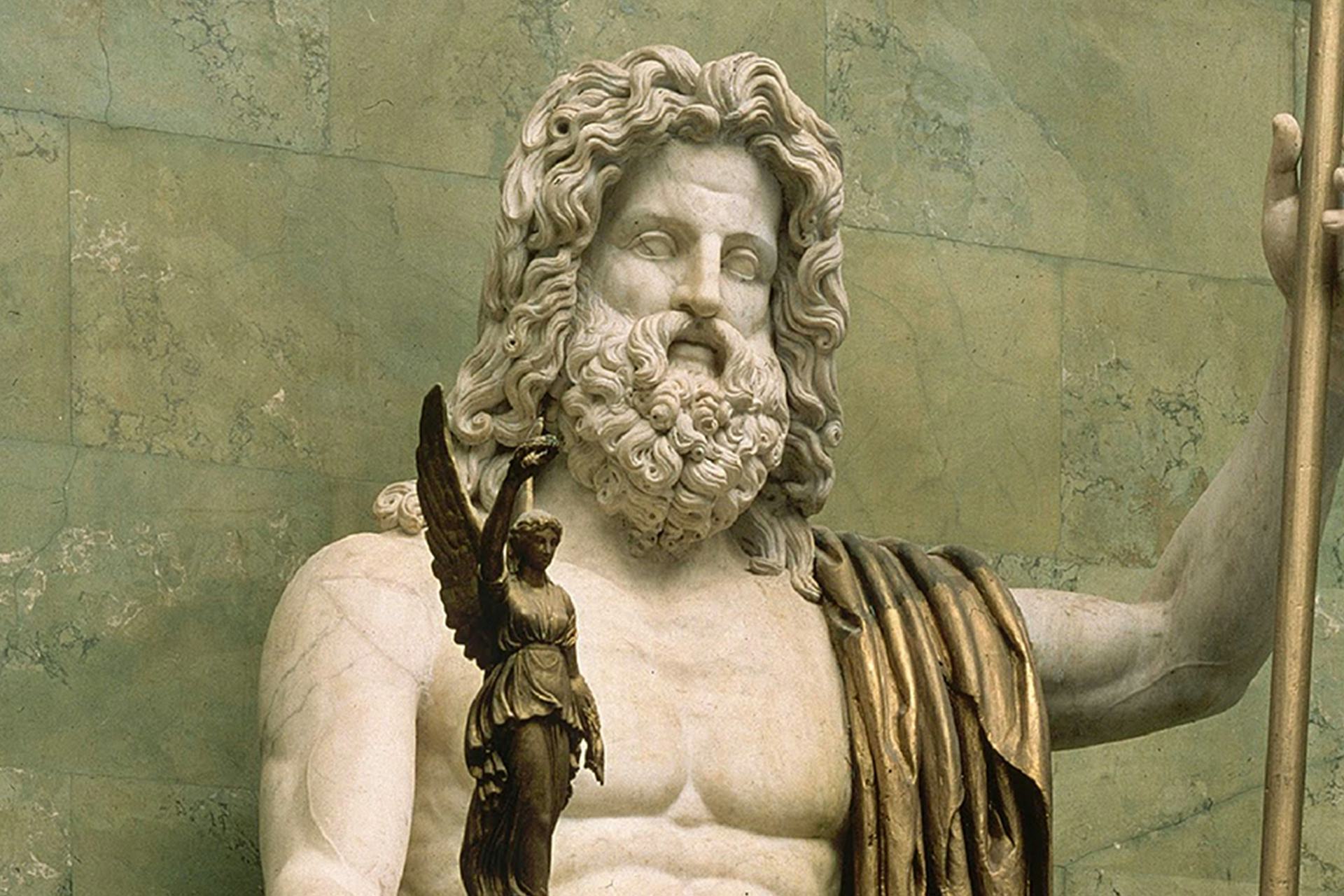
Overview
Zeus was the supreme god of the Greeks, a mighty deity who meted out justice from atop Mount Olympus. Hailed as the father of both mortals and immortals, Zeus was the god of the sky and weather, but was also connected with law and order, the city, and the household.
The numerous other gods of the Greek pantheon were all subordinate to Zeus, and none could rival him in power. Zeus’ wife and queen was Hera, goddess of women and marriage. The two had several divine children together, though Zeus also fathered numerous children through other marriages and affairs.
Greek myth and religion emphasized Zeus’ supreme power, but also his role as a source of justice. To the Greeks, Zeus represented the world order as they saw it. He was worshipped throughout the Greek world, with major Panhellenic sanctuaries at Olympia and Dodona.
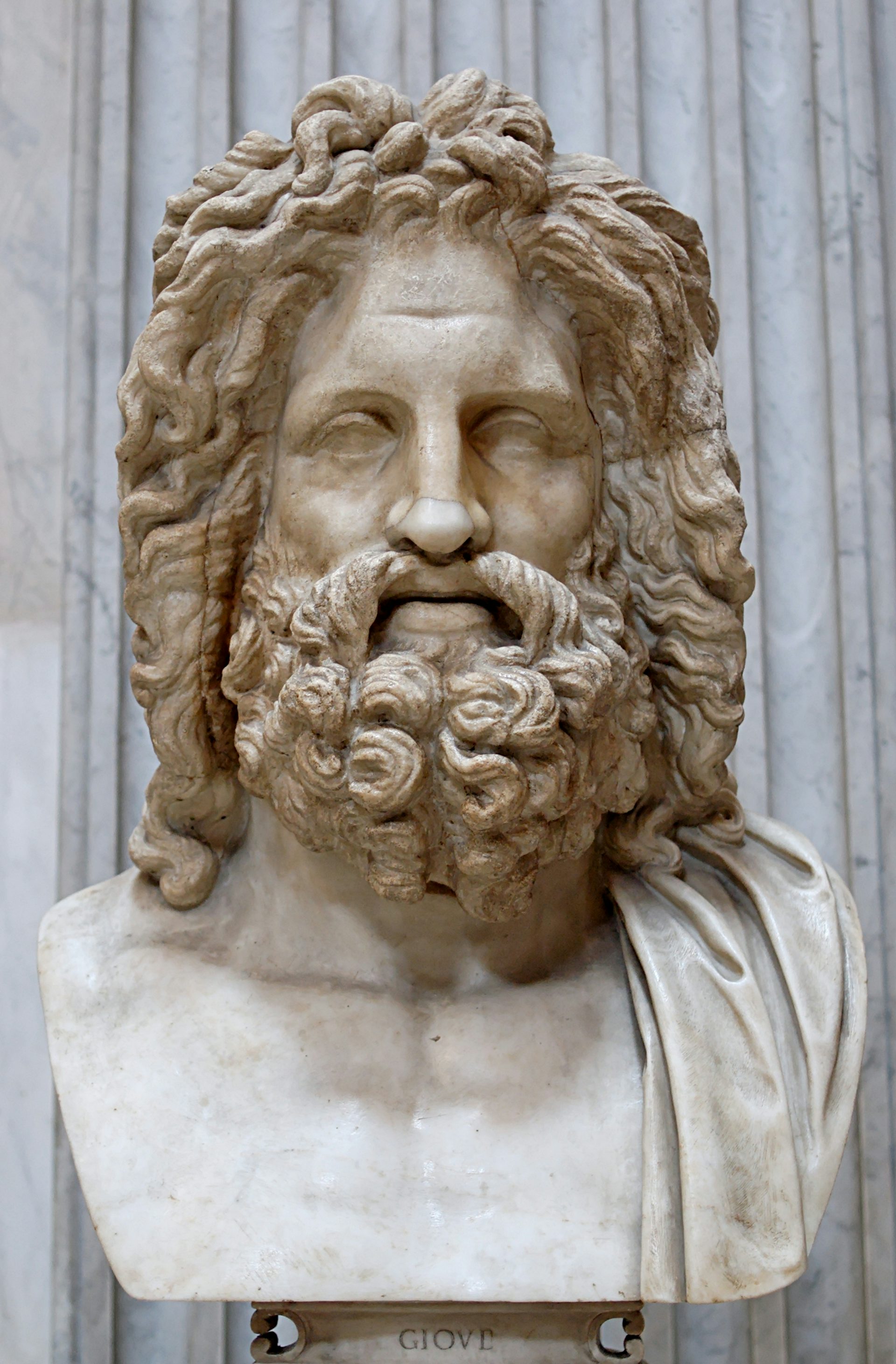
The "Zeus of Otricoli," Roman statue of Zeus after a Greek original from the fourth century BCE
Vatican Museums, Vatican / JastrowPublic DomainKey Facts
Who were Zeus’ parents?
Zeus was the son of the Titans Cronus and Rhea, who ruled over the cosmos before the Olympians. His siblings were the gods Hestia, Demeter, Hera, Poseidon, and Hades.
Zeus eventually led his siblings in a war against Cronus and the other Titans. After winning the war and banishing the Titans to Tartarus, Zeus and his siblings—dubbed the “Olympians” because they lived atop Mount Olympus—appointed themselves the new rulers of the cosmos.
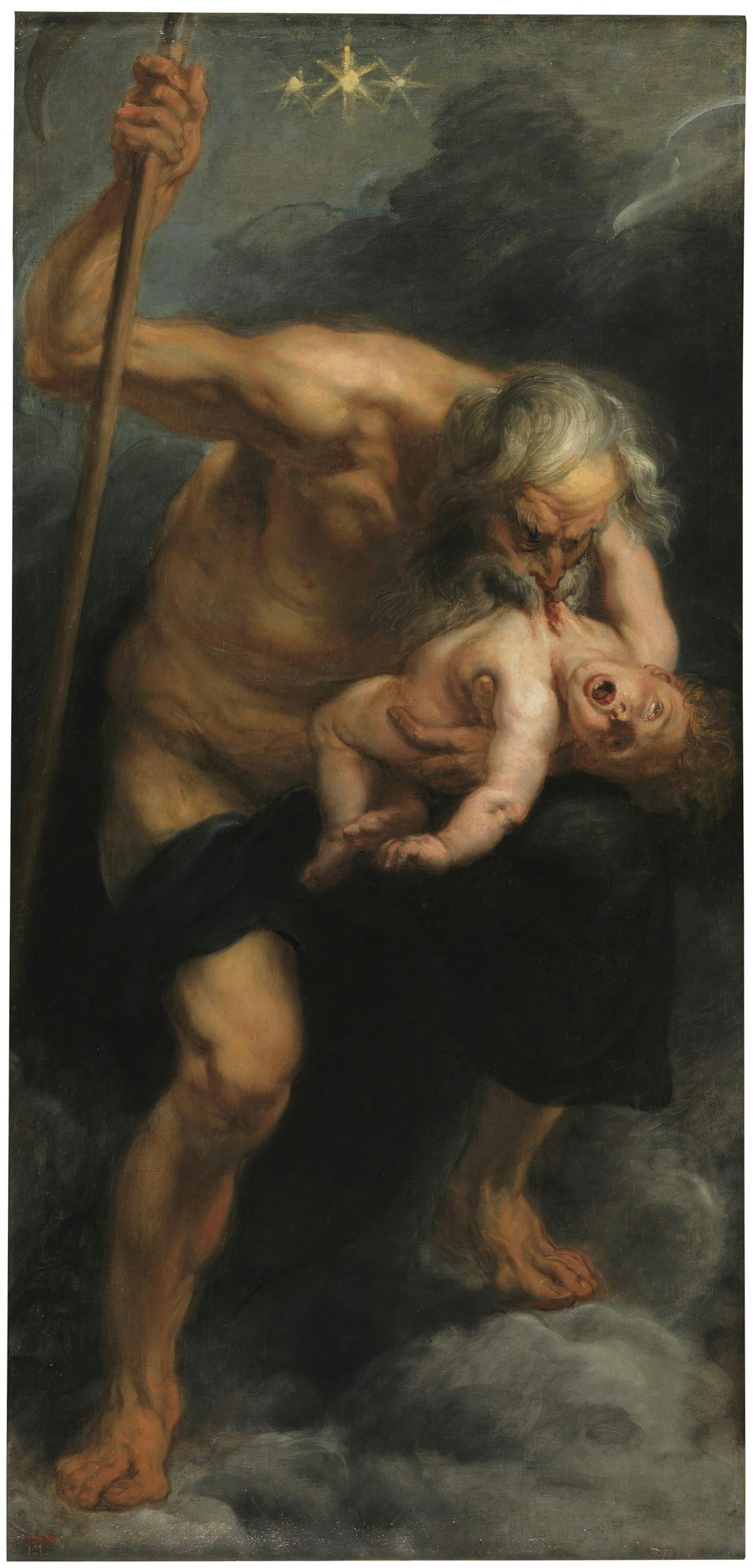
Saturn by Peter Paul Rubens (between 1636 and 1638)
Museo del Prado, MadridPublic DomainWho were Zeus’ children?
By Hera, his queen, Zeus fathered several important children, including the war god Ares, the childbirth goddess Eileithyia, and (at least in some traditions) the smith god Hephaestus. But Zeus also had children by other marriages, including the Muses by Mnemosyne and Persephone by Demeter.
Zeus’ mythology contains countless tales of his affairs with goddesses, nymphs, and mortals of all sorts. From these various consorts (well exceeding 100!), Zeus had numerous children, including the gods Apollo, Artemis, Athena, and Hermes, the heroes Heracles and Perseus, and the beautiful queen Helen.
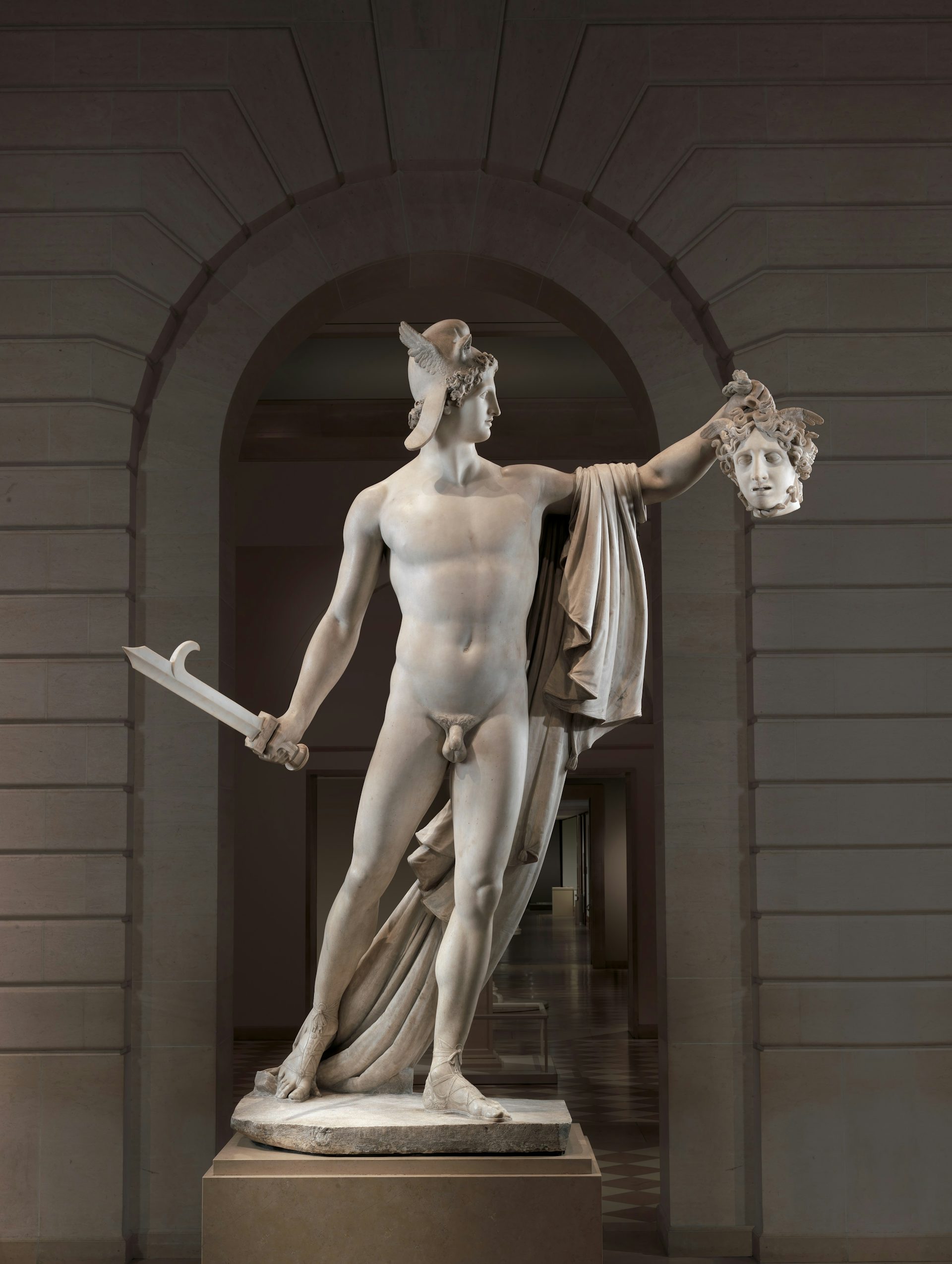
Perseus with the Head of Medusa by Antonio Canova (1804–1806)
The Metropolitan Museum of ArtPublic DomainWhat were Zeus’ attributes?
Zeus was traditionally depicted as a well-muscled and bearded deity. His chief attributes were thunder and lightning—the symbols of his authority as the god of storms and weather—as well as a scepter, representing his role as the ruler of the cosmos. In literature especially, Zeus sometimes wielded the aegis, an invincible shield.
Zeus was also represented by certain animals, especially the eagle, which was often shown perched upon the god’s scepter. He was frequently shown in the company of other deities—most notably, his fellow Olympians.
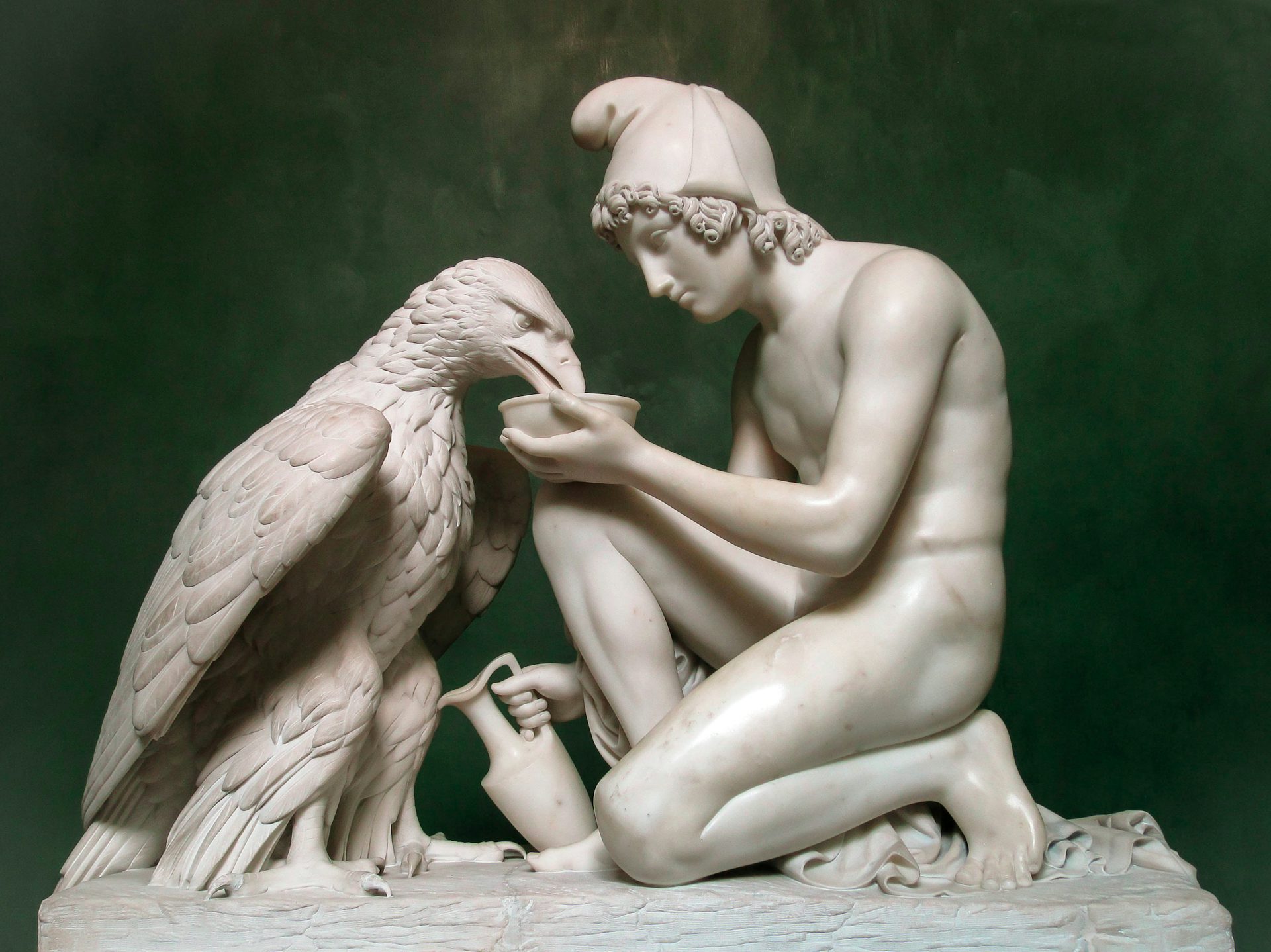
Ganymede with Zeus as an Eagle by Bertel Thorvaldsen (1817)
Thorvaldsen Museum, Copenhagen / CarstenNorgaardCC BY-SA 3.0Zeus defeats Cronus
For all his strength, Zeus’ power was neither unlimited nor unchallenged. Before becoming king of the gods, he first needed to defeat his tyrannical father Cronus.
Fearing his own children would overthrow him, Cronus had decided to devour each of them as soon as they were born. But Zeus’ mother Rhea rescued him by giving Cronus a stone to swallow instead, and the young Zeus was brought up in secret.
Once he had come of age, he waged war against Cronus and the other Titans, defeated them, and appointed himself the new ruler of the cosmos.
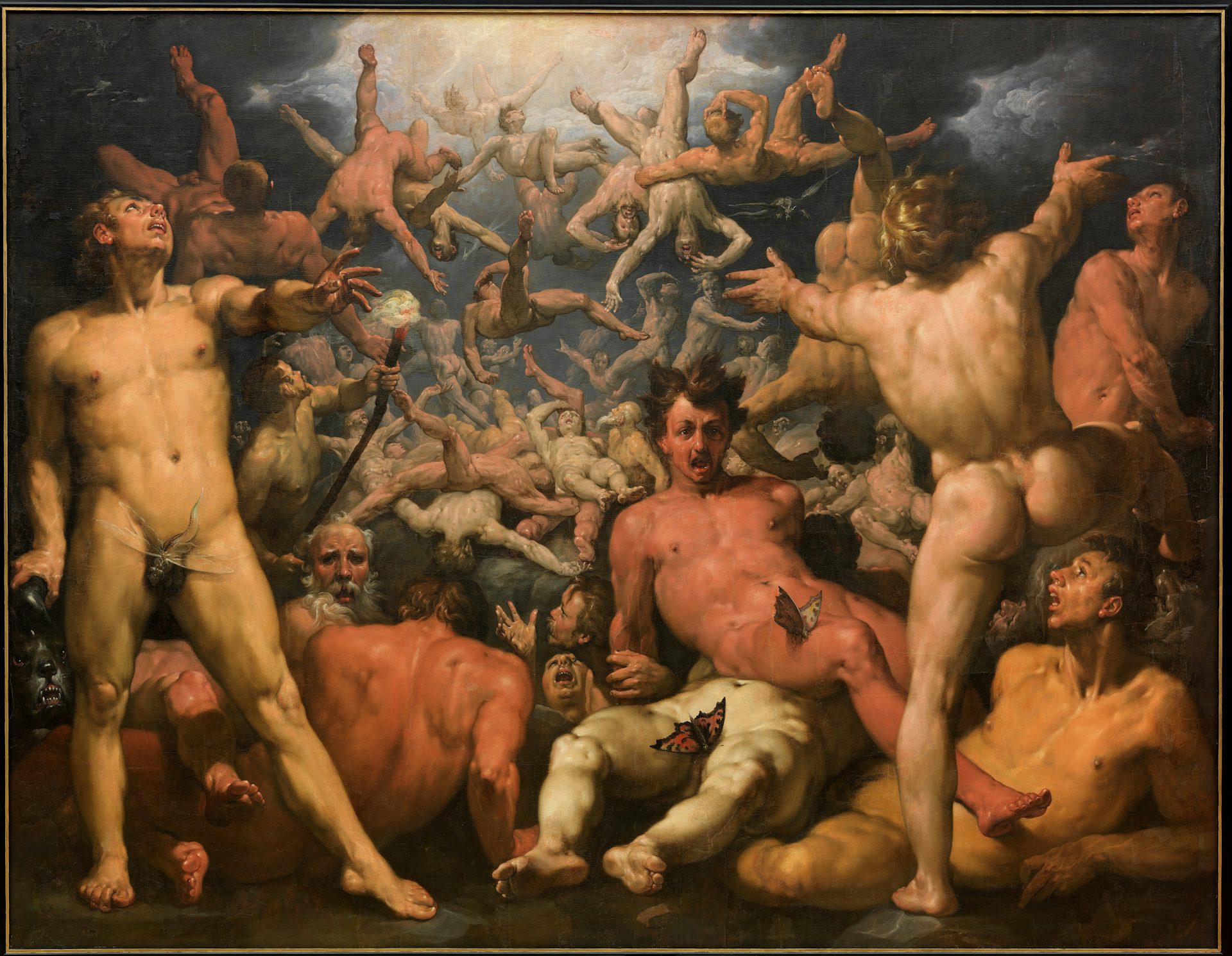
The Fall of the Titans by Cornelis van Haarlem (1588–1590)
Statens Museum for Kunst, CopenhagenPublic DomainRoles and Powers
In ancient literature, art, and cult, Zeus was typically represented as a god of the sky and weather—and thus, by extension, the god who controlled lightning, thunder, rain, snow, and other meteorological phenomena.[1] The most recognizable symbols of his power and dominion were lightning and thunder; the dreaded thunderbolts he wielded were said to have been fashioned for him by the Cyclopes.
Zeus was also the supreme god of the Greeks and was therefore often invoked as the divine “father” (metaphorically, not literally—though he did have many children). As the ruler of both gods and humans,[2] Zeus was the strongest of the Greek gods. In the Iliad, for example, Zeus boasts that he can easily overpower all the gods in a pulling contest:
Make ye fast from heaven a chain of gold, and lay ye hold thereof, all ye gods and all goddesses; yet could ye not drag to earth from out of heaven Zeus the counsellor most high, not though ye laboured sore. But whenso I were minded to draw of a ready heart, then with earth itself should I draw you and with sea withal; and the rope should I thereafter bind about a peak of Olympus and all those things should hang in space. By so much am I above gods and above men.[3]
As the highest ruler of the cosmos, Zeus was also a god of order and the fate of human beings (what the Greeks called moira or aisa). In the Iliad, Zeus chooses who prospers and who suffers:
For two urns are set upon the floor of Zeus of gifts that he giveth, the one of ills, the other of blessings. To whomsoever Zeus, that hurleth the thunderbolt, giveth a mingled lot, that man meeteth now with evil, now with good; but to whomsoever he giveth but of the baneful, him he maketh to be reviled of man, and direful madness driveth him over the face of the sacred earth, and he wandereth honoured neither of gods nor mortals.[4]
Zeus was responsible for guiding not only individual lives but also the course of world events; it was often said that all things followed the “plan” or “will” of Zeus.[5] But Zeus’ authority was not absolute. Ultimately, it was the Moirae, or “Fates,” who determined the overall course of fate; even Zeus was powerless to resist what the Moirae decreed.
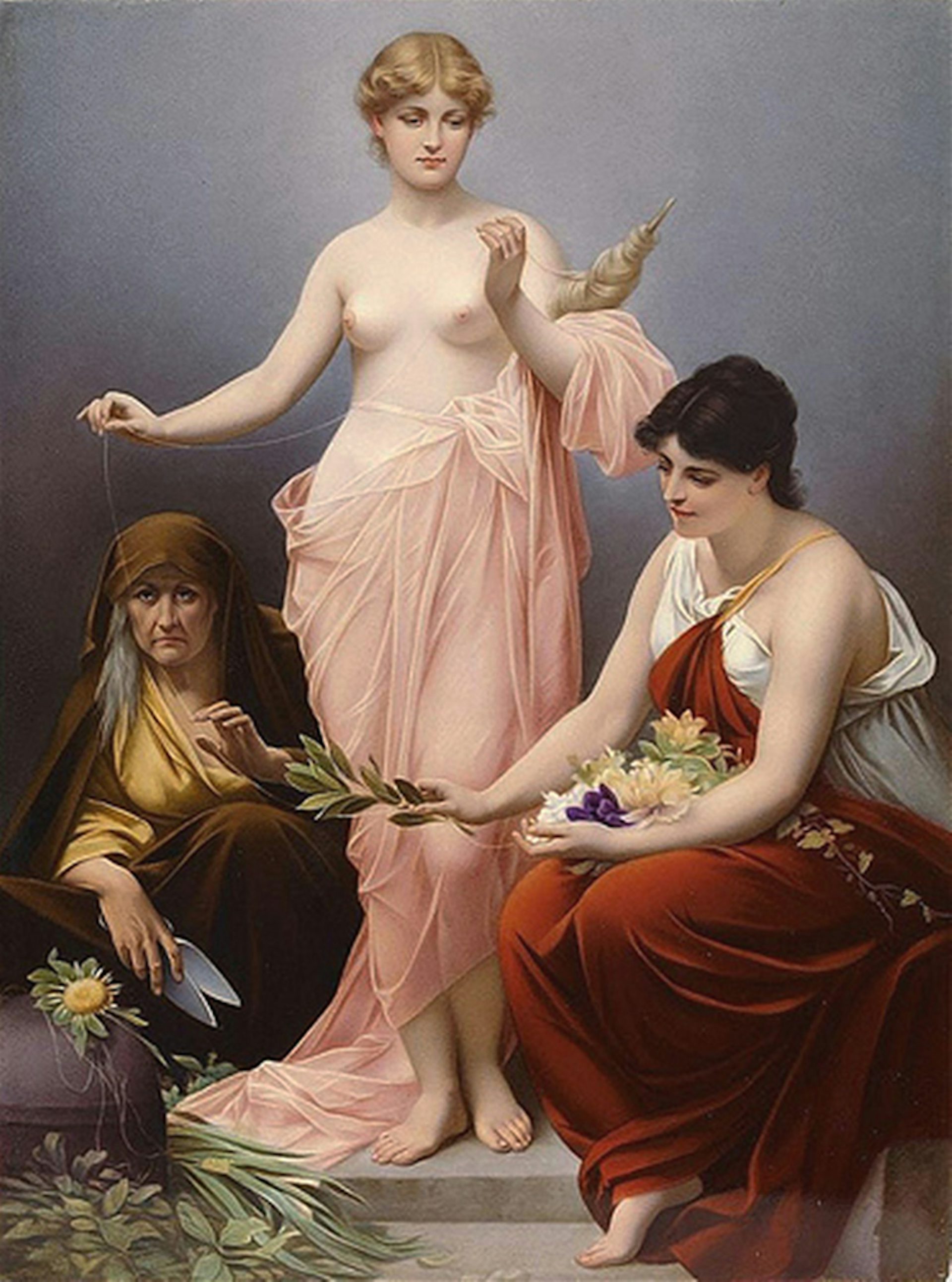
The Three Fates by Paul Thumann (19th century)
Wikimedia CommonsPublic DomainThough he did not have complete control over fate, Zeus was regarded as the guarantor of world order and justice. With the help of a host of divine watchers and spirits, Zeus supervised the human world, learning of all transgressions and ensuring that justice was done.[6] Likewise, it was Zeus who was said to give kings the right to dispense justice,[7] and Zeus who was invoked as the protector of suppliants, strangers, and beggars.[8]
Zeus was invoked in many other natural, domestic, and institutional capacities. For example, he was perceived as the protector of the city (polis), the marketplace (agora), the home, and the family. Zeus was also a god of prophecy, with an early and important oracle at Dodona (see below).
Zeus could also be invoked as a chthonic god—that is, a god of the earth and the Underworld. In this guise, he was connected with the fertility of the soil[9] as well as with cults of expiation and purification.
Attributes
Symbols
Zeus’ most familiar symbol was the thunderbolt (fashioned for him by the Cyclopes), which he wielded as a formidable weapon.[10] The ancient Greeks believed that places where lightning had struck had been hallowed by Zeus and were therefore taboo (abaton in Greek). Zeus was also shown with other trappings of power, such as a scepter or a crown of olive, oak, or laurel leaves.
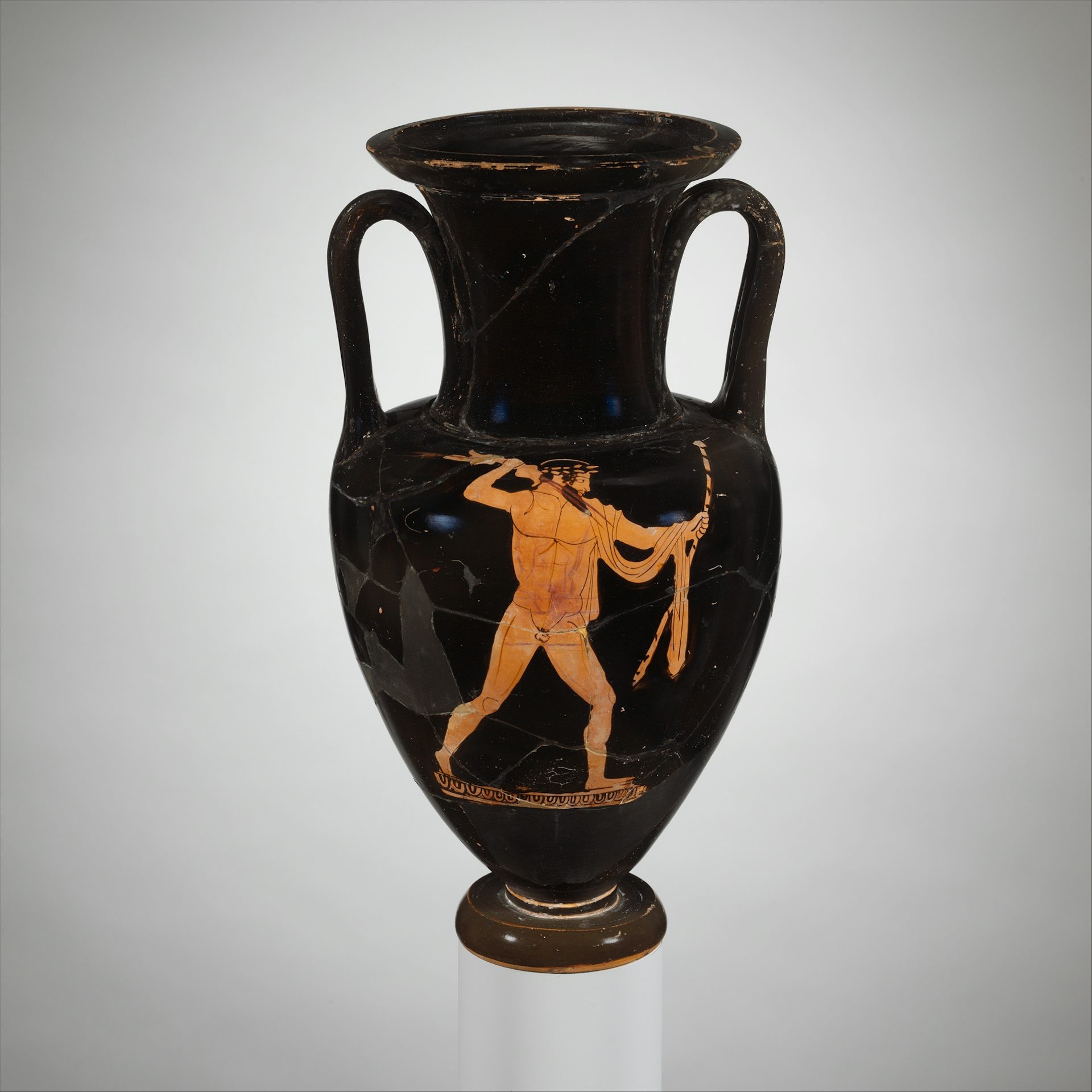
Obverse of an Attic red-figure Nolan neck-amphora (ca. 460–450 BCE) showing Zeus wielding the thunderbolt
The Metropolitan Museum of ArtPublic DomainWhen he went into battle, Zeus carried the aegis, an invincible shield covered in a goatskin. Though other gods, especially Athena, sometimes carried the aegis, too, it was typically said that Hephaestus had made it specifically for Zeus, endowing the shield with magical powers to put enemy warriors to rout.[11]
Zeus was also associated with certain animals, especially the eagle and the bull. Pindar’s first Pythian Ode, for instance, evocatively describes the eagle of Zeus, which “sleeps on the scepter of Zeus, relaxing his swift wings on either side, the king of birds.”[12]
Certain plants and trees appeared as symbols of Zeus as well. At the oracle of Zeus at Dodona, for example, there was a grove of oak trees that was sacred to Zeus; it was said that the god spoke through these trees on occasion. Moreover, in Athens, Zeus (along with Athena) was the protector of the olive tree, the most important tree in the region.
Personality
Zeus was the most powerful being in the traditional Greek cosmos—the embodiment of sovereignty, order, and justice. The ancient Greeks thus imbued him with characteristics that reflected this identity. Though he did not have absolute power, Zeus was unrivaled among the gods; he controlled his fellow deities by right, but also by force if necessary. In the Iliad especially, Zeus does not hesitate to use threats of violence to get what he wants.
As time wore on, the Greeks’ depiction of Zeus softened, and he was increasingly represented as a god who ruled in accordance with the principles of justice, wisdom, and diplomacy. Some ancient works of literature even explicitly claim that Zeus’ character transformed over the course of his rule, with the god gradually abandoning the tyranny of his early reign in favor of a gentler approach.[13]
Many of Zeus’ characteristics reflect key features (both positive and negative) of the ancient Greeks. In his attempts to maintain peace among his plotting peers, Zeus expressed the same yearning for unity felt by the bitterly divided city-states of the Greek world. Meanwhile, Zeus’ many sexual exploits—often nothing more than rapes and attempted rapes—laid bare the deeply misogynistic culture of the Greeks.[14]
Indeed, Zeus’ exploits and triumphs reveal much about the Greeks who worshipped him. Both powerful and just, Zeus embodied the spirit of the Hellenes at their best—warrior-poets whose military vigor was matched only by their dedication to the law and order of the polis (city-state). Zeus was not simply the powerful god the Greeks looked to when they gazed at the sky; he was also an idealized reflection of themselves.
Dwellings
Zeus lived alongside the other Olympians, who took their name from their home atop Mount Olympus. This mountain, physically located in northern Greece, was represented in antiquity as more of a heavenly, otherworldly realm than a true mountain (though literary descriptions of Olympus did sometimes stress its mountainous features, including crags and cliffs).[15]

A view of Mount Olympus from the village of Kokkinopilos, Greece
stefg74CC BY 2.0On Olympus, Zeus had his own grand palace; like the homes of the other Olympians, it was built in lavish style by the smith god Hephaestus.[16] The gods would gather in Zeus’ palace to hold council.[17]
Iconography
As the ruler of the cosmos, Zeus was a common subject in ancient art. Early images often showed the god striding forward, thunderbolt in hand (this iconographic type is known as “Zeus Keraunios,” or “Zeus the Thunderer”). By the Classical period (490–323 BCE), Zeus’ iconography had softened a bit, and he tended to be shown seated, often holding a scepter.
The most famous example of a seated Zeus is the gigantic statue of Zeus at Olympia, fashioned in chryselephantine (gold and ivory) by the artist Phidias in the second half of the fifth century BCE. Considered one of the Seven Wonders of the Ancient World, the statue was destroyed long ago, but detailed descriptions of it have survived from antiquity.[18] Zeus is also at the center of the pediment friezes on the Parthenon in Athens.
Ancient artists placed Zeus in a variety of mythological scenes. Vase paintings and sculptures often depicted his amorous pursuits, chasing after figures such as Europa, Leda, or Ganymede. He also frequently appeared in scenes from the Gigantomachy, fighting against the Giants with the other Olympian gods. Such scenes were popular in vase painting but were also represented on a monumental scale on the Pergamon Altar (first half of the second century BCE).
Throughout antiquity, Zeus was often pictured on coins as well.
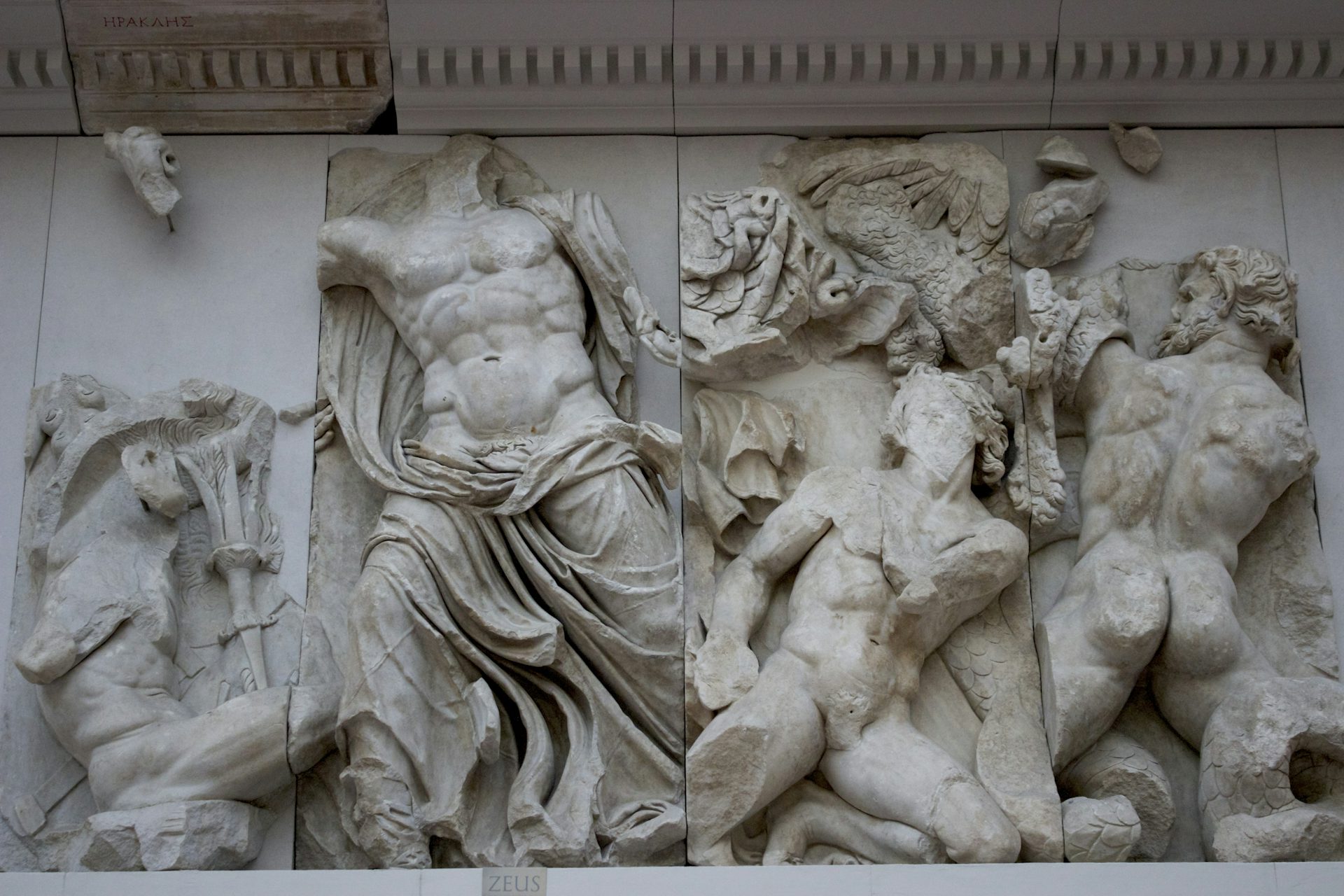
Frieze of the Pergamum Altar showing Zeus in battle against the Giants (first half of the second century BCE)
Miguel Hormoso CuestaCC BY-SA 4.0During the Hellenistic period (323–31 BCE), Zeus tended to appear with other figures, in “group” scenes such as the Gigantomachy. During this same period, many Hellenistic emperors—and, subsequently, Roman emperors—appropriated Zeus’ image for propagandistic reasons, identifying themselves with the supreme god.
Finally, some representations of Zeus as a chthonic or earth deity showed him in the form of a snake. Zeus Ktesios, or Zeus as god of personal property, was often depicted this way, reflecting the ancient notion of wealth being connected with the earth or soil.[19]
Etymology
Pronunciation
English
Greek
Zeus Ζεύς (Zeús) Phonetic
IPA
[zoos] /zus/
Other Names
There were many dialectical variants of Zeus’ name in antiquity. These included the forms Δεύς (Deús), Δίς (Dís), Ζήν (Zḗn), Δάν (Dán), and Ζάς (Zás), among others.
Zeus’ Roman equivalent was called Jupiter.
Titles and Epithets
Zeus had many titles and epithets, reflecting his diverse roles and functions across diverse regions of the ancient world. In fact, over 1,000 epithets and cult titles (also called “epicleses”) are known from literature and inscriptions.[22]
Some of Zeus’ most important and familiar epithets were tied to his rule as the supreme paternal god of the Greek cosmos. Zeus was thus often known as ἄναξ (ánax), “lord,” or πατήρ (patḗr), “father.” In Homer and Hesiod, he is often called πατὴρ ἀνδρῶν τε θεῶν τε (patḗr andrôn te theôn te), “father of men and gods.” Moreover, as high god of the Olympians, Zeus was known in many contexts simply as Ὀλύμπιος (Olýmpios), the “Olympian.”
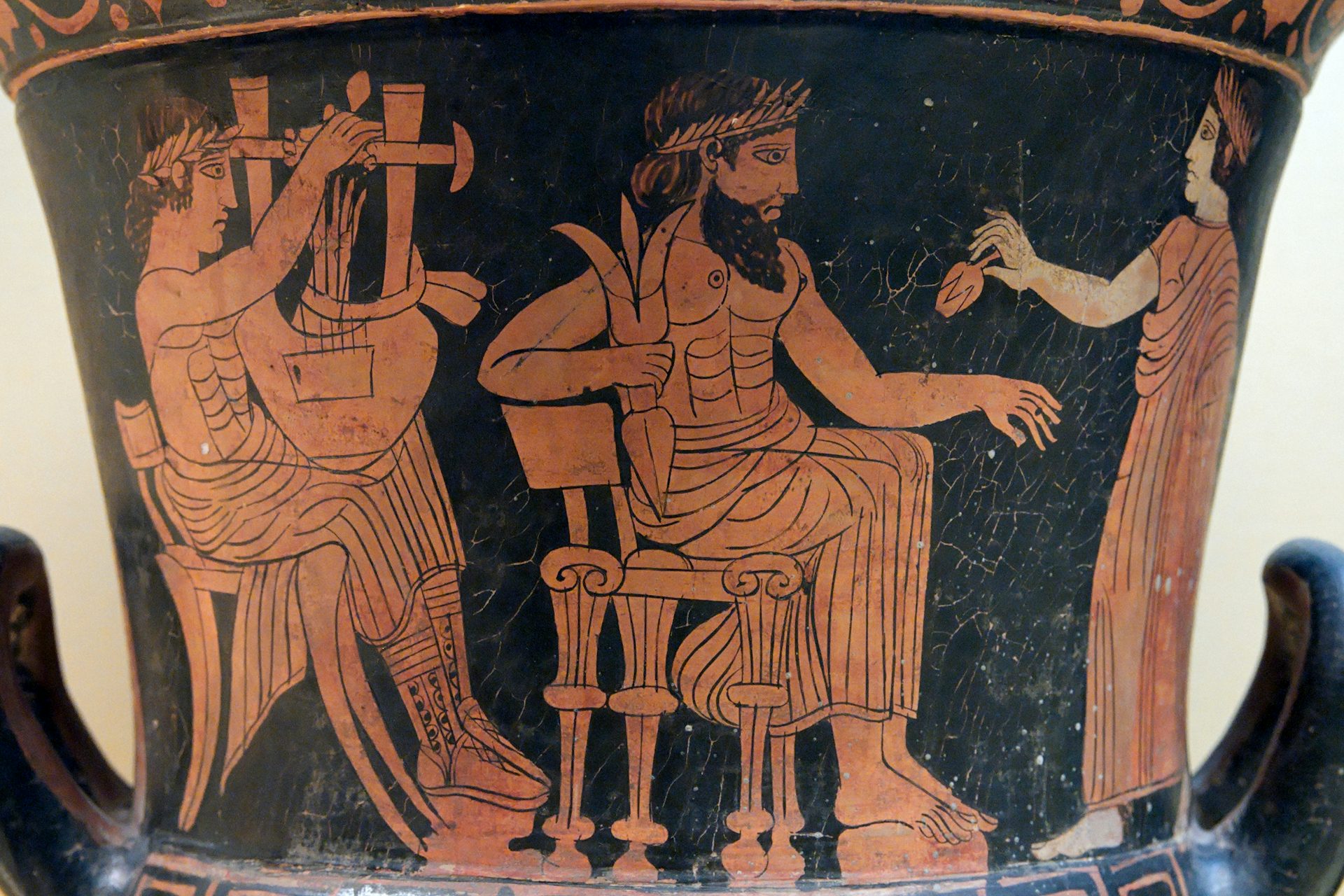
Etruscan red-figure calyx krater by the Painter of London F484 (ca. 420–400 BCE) showing Apollo (left), Zeus (center), and Hera (right)
National Archaeological Museum, Madrid / Marie-Lan NguyenCC BY 2.5Other epithets of Zeus were more specific. As the god of rain, storms, thunder, and lightning, he had titles and epithets such as ὑέτιος (hyétios) or ὄμβριος (ómbrios), “of the rain” or “rainmaker”; νεφεληγερέτα (nephelēgeréta), “cloud-gatherer”; κεραύνιος (keraúnios), “thunderer”; τερπικέραυνος (terpikéraunos), “he who delights in thunder”; ὑψιβρεμέτης (hypsibremétēs), “high-thunderer”; and καταιβάτης (kataibátēs), “he who comes down (as lightning).”
As a god of prophecy and divination, Zeus had titles and epithets such as φαντήρ (phantḗr), “he who gives signs”; τεράστιος (terástios), “he of omens”; and φήμιος (phḗmios) or κληδόνιος (klēdónios), “he who gives oracles.”
As a domestic god who watched over the home, Zeus had titles and epithets such as ἐφέστιος (ephéstios), “of the hearth”; ἑρκεῖος (herkeîos), “of the courtyard”; and κτήσιος (ktḗsios), “of possessions.”
As a god of families and kinship groups, Zeus had titles and epithets such as πατρῷος (patrô(i)os), “of the father”; and φράτριος (phrátrios), “of the clan.”
As a god of interpersonal relations, Zeus had titles and epithets such as ξένιος (xénios), “of hosts”; ἱκέσιος (hikésios), “of suppliants”; and φίλιος (phílios), “of friendship.”
As a god of the Greek polis (city-state) and politics, Zeus had titles and epithets such as πολιεύς (polieús), “of the polis”; ἀγοραίος (agoraíos), “of the marketplace”; and βουλαῖος (boulaîos), “of the council chamber.”
As a god of oaths, Zeus had titles and epithets such as ὅρκιος (hórkios), “of oaths.”
As a protector of individuals, groups, and cities from misfortunes, such as natural disasters and wars, Zeus had titles and epithets such as σωτήρ (sōtḗr), “savior”; ἀλεξίκακος (alexíkakos), “he who wards off evil”; and ἀποτρόπαιος (apotrópaios), “he who turns away (evil).”
Most of the titles and epithets listed above were Panhellenic, meaning they were used by people living in many (if not all) of the diverse regions and city-states of Greece. But some of these titles had specific uses tied to specific locales.
Zeus Polieus, for example, had special local cults in places such as Delos, Cos, Rhodes, Thera, Delphi, Sardis, and Smyrna. Likewise, Zeus Eleutherios (Ἐλευθέριος/Eleuthérios, “of freedom”)—who emerged after the Panhellenic victory over the Persians at the Battle of Plataea in 479 BCE—merged with many local cults of Zeus as he spread across the Greek world.
Other local titles and epithets of Zeus were more location-specific, usually derived from the name of a site where Zeus was worshipped in a special way. Thus, Zeus Lykaios (Λυκαῖος, Lykaîos) was Zeus as worshipped on Mount Lycaeon in Arcardia; Zeus Laphystios (Λαφύστιος/Laphýstios) was Zeus as worshipped on Mount Laphystius in Boeotia; and Zeus La(m)braundos or Labrandeus (Λα(μ)βραύνδος/La(m)braúndos or Λαβρανδεύς/Labrandeús) was Zeus as worshipped in Labranda (or Labraunda), near Mylasa (one of the most important cults of Zeus in Anatolia).
Zeus Olympios, “Olympian Zeus,” was the Panhellenic counterpart of these various local Zeuses. He was the supreme god of all Greeks, ruling the cosmos from atop Mount Olympus.
Other titles and epithets of Zeus referred to specific ritual practices. We thus hear Zeus called aigophágos, “goat-eater,” in connection with goat sacrifices; ElE/koos, “he who listens,” as a god who listened to prayers; or even ikmaîos, “he of humidity,” in connection with rituals of rain magic.
Interestingly—and somewhat paradoxically—the heavenly Zeus could also be invoked in certain ritual contexts as a god of the earth and what lay beneath it. In this capacity, he had titles and epithets such as χθόνιος (chthónios), “of the earth.”
Since the Greeks connected gods of the earth with the Underworld, it was also common practice to invoke the “chthonic” Zeus with euphemistic titles and epithets meant to smooth away the dread the Greeks associated with the dreary Underworld. This is why Zeus sometimes had titles and epithets such as μειλίχιος (meilíchios), “gentle”; εὐμένης (euménēs), “benevolent”; and ἠλάστηρος (ēlástēros), “expeller.”
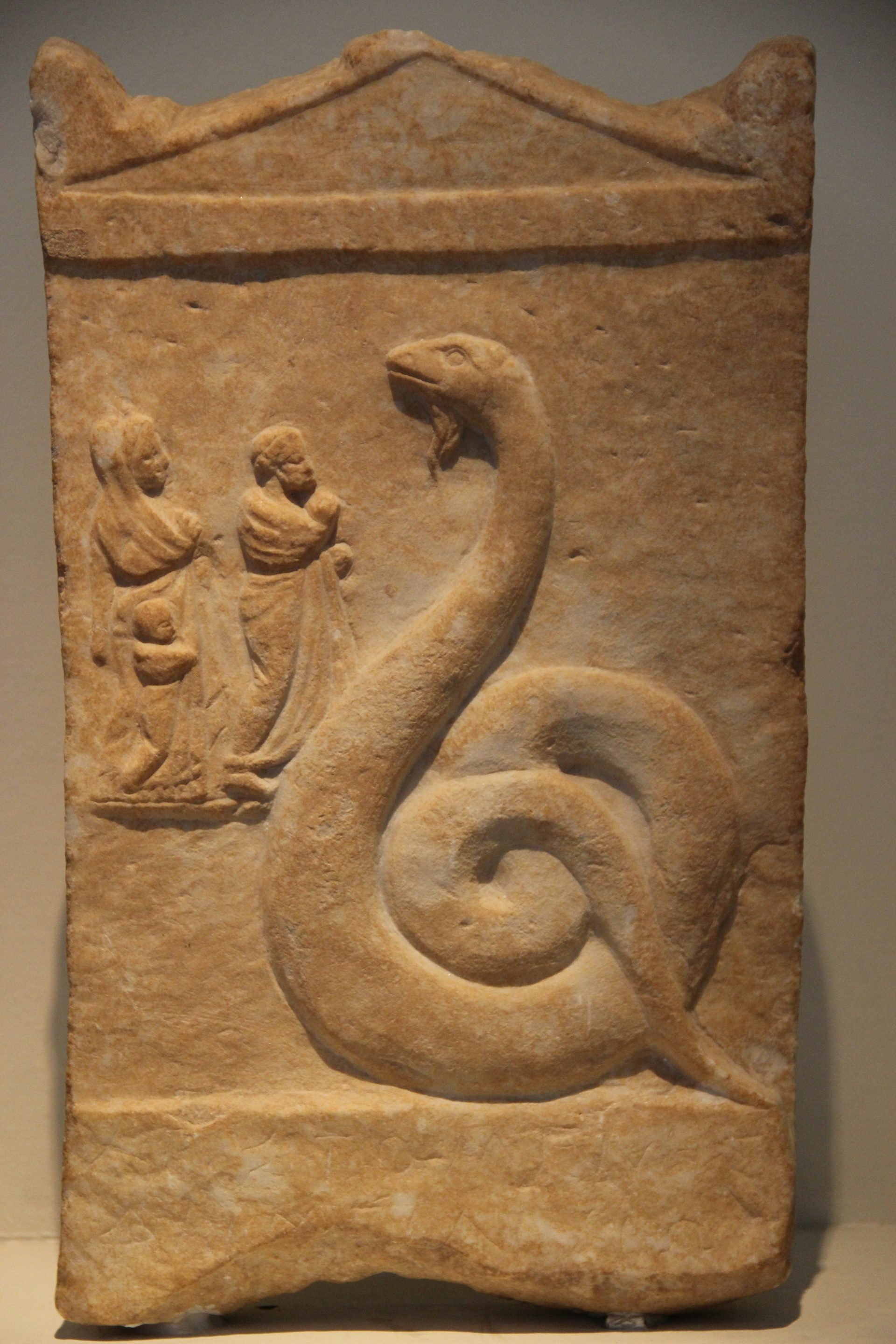
A marble votive relief showing Zeus Melichios as a snake, dedicated by Aristomenes (ca. 350–300 BCE)
National Archaeological Museum, Athens / Gary ToddCC0Family
Family Tree
Parents
Father
Mother
Siblings
Brothers
Sisters
Consorts
Wives
Lovers
Children
Daughters
Sons
Mythology
Origins
Like the supreme deities of many other mythologies (including the Indian Dyaus and the Italian Jupiter), Zeus originated from the Indo-European sky god. He is attested from as early as 1450 BCE at the Mycenaean sites of Knossos, Pylos, and Chania, appearing as diwo or diwe on tablets written in Linear B (the syllabic writing system used by the Greeks during the Bronze Age).
Evidence from this early period mentions cults of Zeus in connection with other gods, including Dionysus and Hera, as well as Drimios—a god never mentioned in later sources, but who is named as a son of Zeus.[45]
The myths of Zeus, especially those involving the god’s rise to power, show considerable Near Eastern influence. Notably, the “succession myth” of Hesiod’s Theogony—in which rule of the cosmos passes from the sky god Uranus to the Titan Cronus, and from Cronus to the storm god Zeus—closely resembles the cosmogonic and theogonic myths of the Hurrians and Hittites. In those traditions, power passed from Alalu to the sky god Anu, from Anu to his cupbearer Kumarbi, and from Kumarbi to the storm god Teshub (or Tarhunna).
The story of how Zeus wrested control of the cosmos from the chaotic forces of nature also has parallels in the Babylonian Enūma Eliš, which describes how the young god Marduk overcame the primordial sea gods Apsu and Tiamut to become the supreme god.
Likewise, the battle between Zeus and Typhoeus seems to have been adopted from Near Eastern sources. Indeed, there was even one Greek tradition that associated this battle with the Syrian Mount Casius, a site sacred to the Semitic god Baal Sapon (a storm god like Zeus), who fought against a Typhoeus-like monster called Yam.[46] In the Hurro-Hittite tradition, a similar monster called Ulikummi (or Illuyanka) was likewise defeated by Zeus’ counterpart Teshub (or Tarhunna).[47]
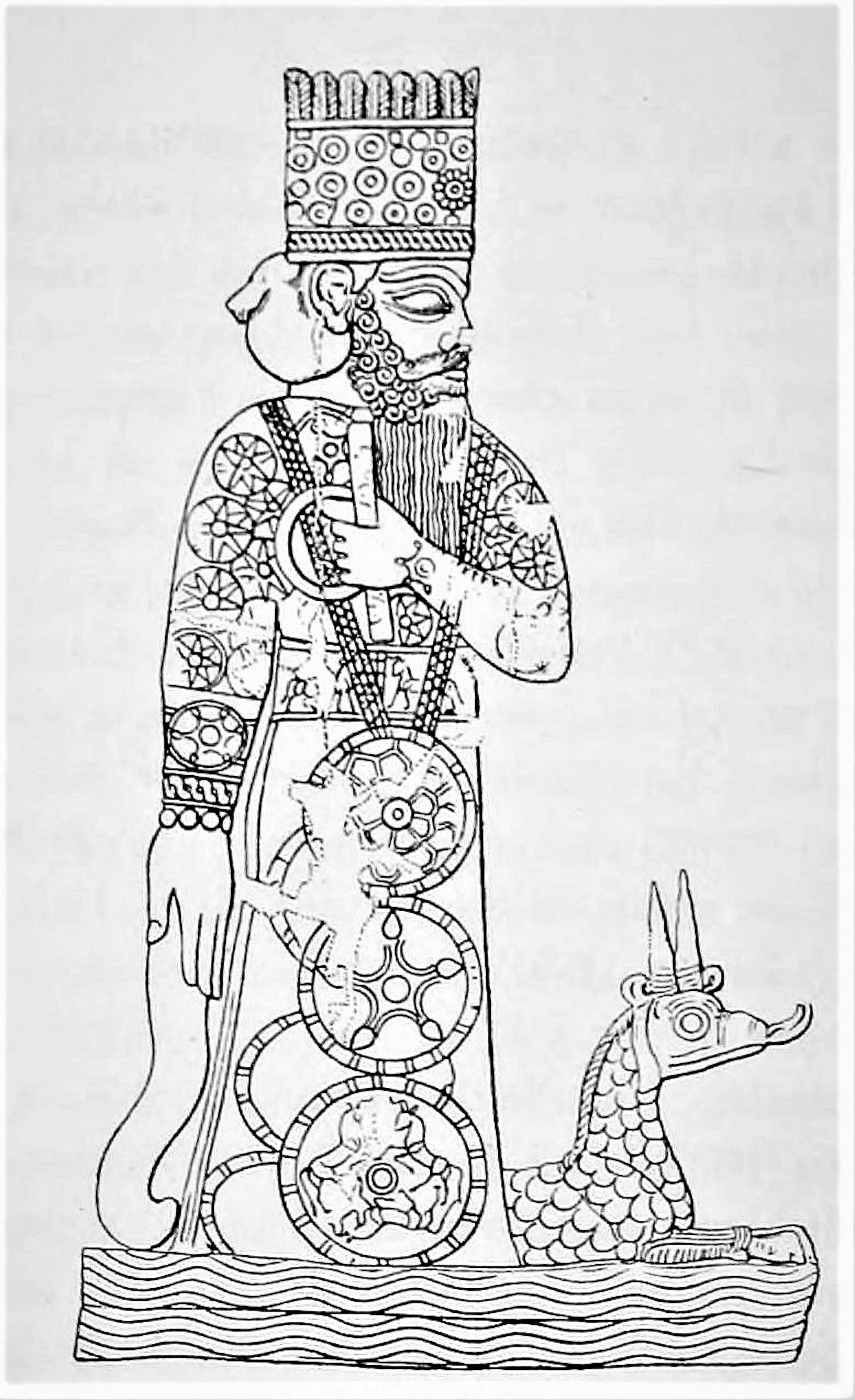
Illustration of a statue of Marduk depicted on a 9th century BCE cylinder seal
Franz Heinrich Weißbach, Babylonischen Miscellen (1903)Public DomainBirth and Childhood
According to myth, Zeus was the last of the six children born to the Titans Cronus and Rhea. He came into being at a chaotic and uncertain time: Cronus had just seized control of the heavens from his father Uranus, one of the primordial deities and the overlord of the sky.
Fearing that his own children would usurp him (just as he had his father), Cronus ate his first five children—Hestia, Demeter, Hera, Hades, and Poseidon. Determined to save her next child, Rhea stole away while she was pregnant with Zeus and delivered him in secret.
Rhea entrusted the child to her mother Gaia, the primordial goddess of the earth, who hid him in a cave. To complete this deception, Rhea returned with a stone wrapped in swaddling blankets and gave it to Cronus, who devoured it as he had the others. The ruse was thus a success.[48]
In the most familiar version of the myth, Zeus was born on the island of Crete, but ancient sources often disagreed on the exact location of the cave in which he was hidden. According to Hesiod, Zeus was raised on Mount Aegaeon, near the Cretan city of Lyctus,[49] but in other accounts he was raised on Mount Dicte[50] or Mount Ida.[51]
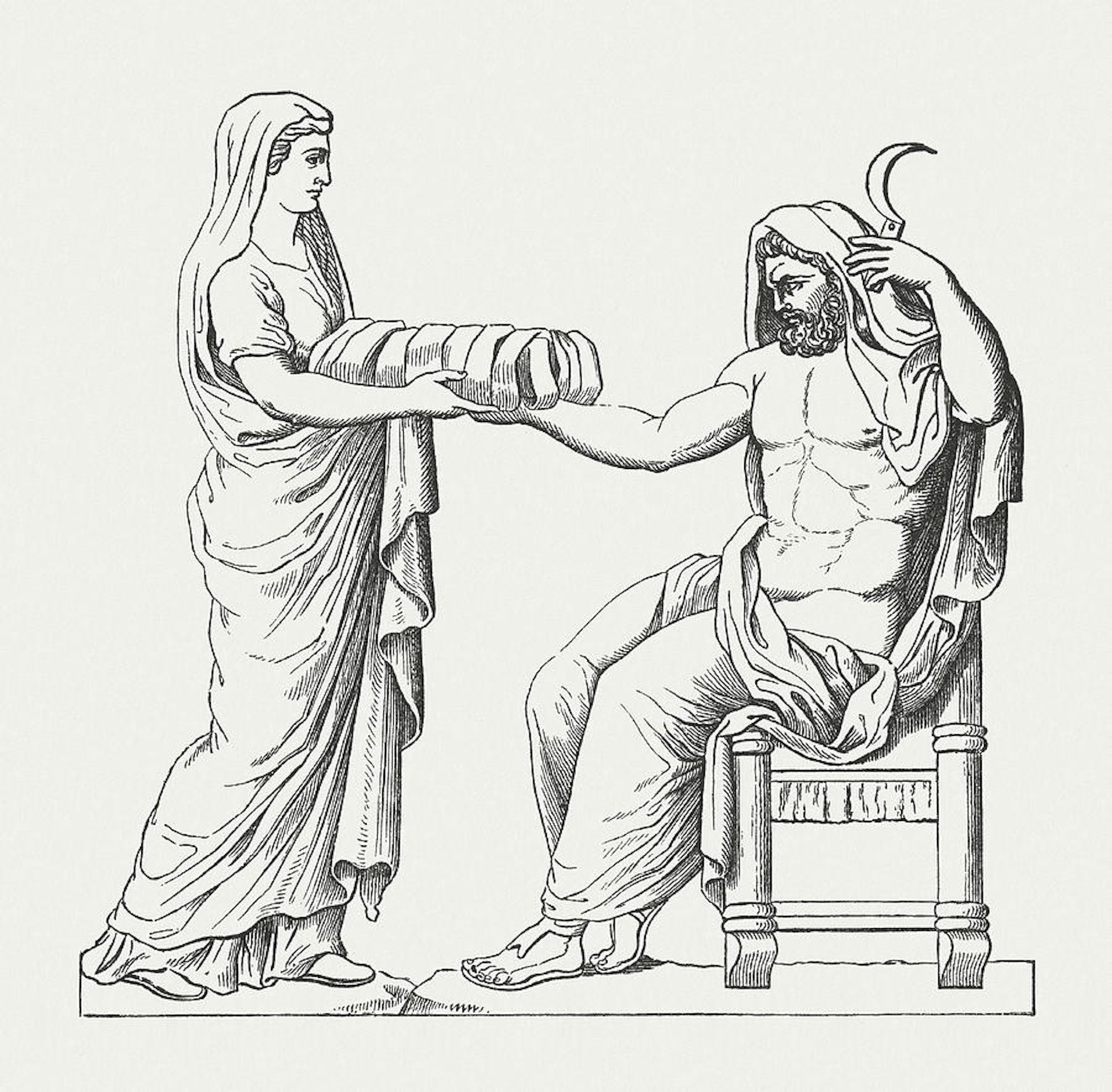
Rhea presents Cronus the stone wrapped in cloth, woodcut engraving from The Olympus or the Mythology of the Greeks and Romans by August Heinrich Petiscus (1878).
Wikimedia CommonsPublic DomainThere are different versions of Zeus’ infancy. In the best-known tradition, he was suckled by the she-goat Amalthea while a troop of armed warriors called the Curetes danced and clashed their weapons to conceal the baby’s cries from Cronus.[52]
But there were numerous variations on this tradition. In one version, Rhea entrusted Zeus to her sister Themis rather than Gaia, and Themis in turn entrusted Zeus to a nymph named Amalthea, whose goat it was that nursed the infant.[53]
In another variant, Zeus was nursed by the daughters of a certain Melisseus (named as Adrasteia and Ida in some sources).[54] In still other traditions, Zeus was fed by various other animals, such as bees or a sow.[55]
Another story told of how Amalthea—a nymph in this tradition—devised a cunning plan to prevent Cronus from finding Zeus. Since Cronus ruled the earth, the heavens, and the sea, Amalthea hid the young Zeus by hanging his cradle from a tree: suspended between the three realms, Zeus was invisible to Cronus.[56]
Zeus’ childhood is conveyed through a number of colorful myths. In one, a band of Cretan bandits snuck into Zeus’ cave to steal the honey of the sacred bees that fed the young god. Zeus caught them and used his power to split their armor. He would have killed them, too, but Themis and the Moirae reminded him that it was forbidden for anyone to die on sacred ground. Zeus thus changed them into birds instead.[57]
In another myth, Cronus came to Crete in search of Zeus, but Zeus outwitted his father by transforming himself into a snake and his nurses into bears. This act of deception was commemorated in the constellations of the Dragon and the Greater and Lesser Bear.[58] Alternatively, Zeus was spirited away to Naxos when Cronus came to Crete and spent the rest of his childhood there.[59]
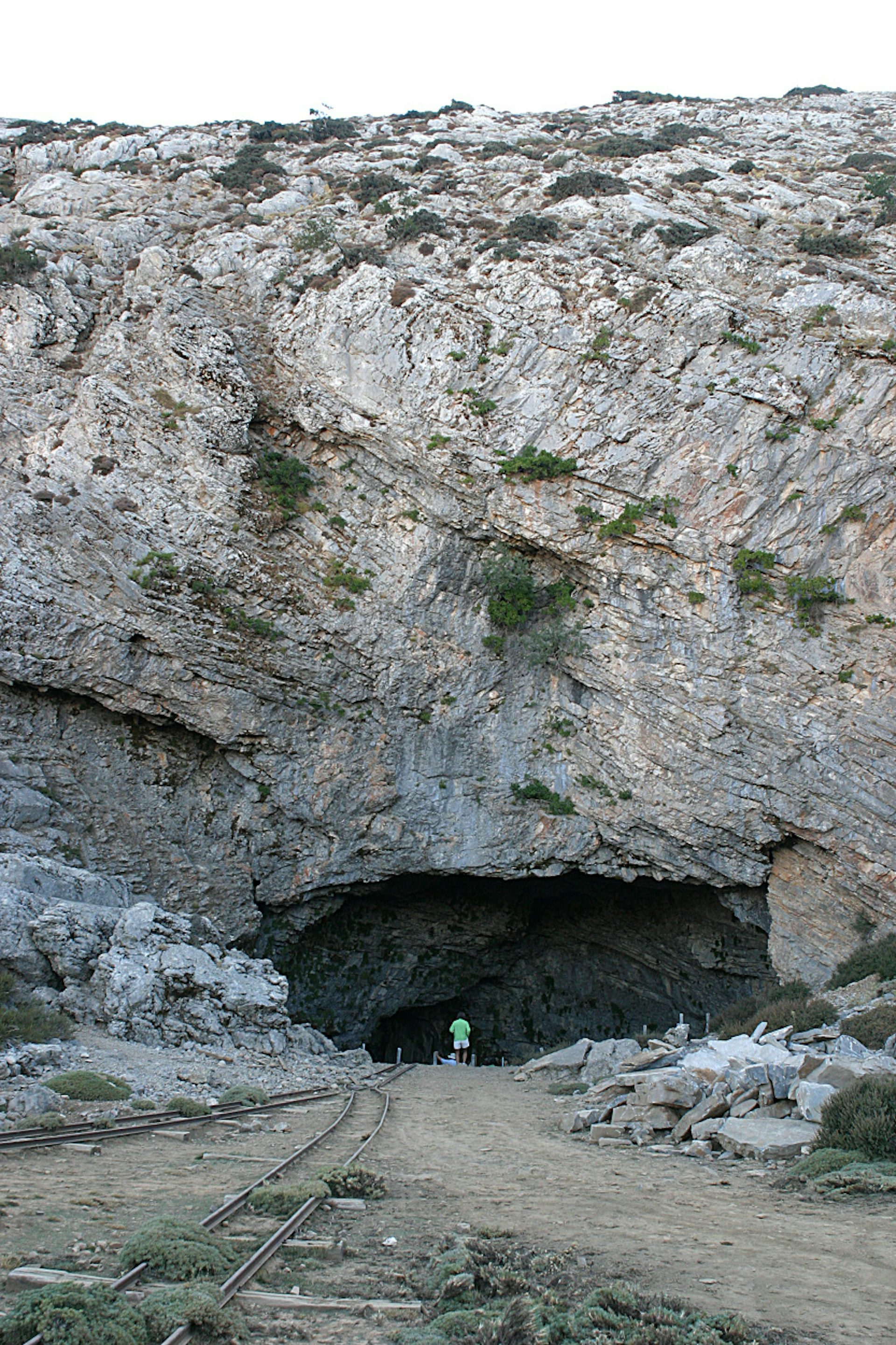
Photo of the cave of Mount Ida in Crete, where the infant Zeus was said to have been brought up
Henry HartleyCC BY 3.0The Titanomachy
When he reached manhood, Zeus left Crete to confront Cronus. First, he tricked Cronus into drinking a potion that caused him to vomit up the children he had swallowed.[60] Once Zeus and his siblings were reunited, they set out to overthrow Cronus and the rest of the Titans.
This sparked the conflict known as the Titanomachy. For ten years, the Titans did battle with Zeus and his siblings (as well as Prometheus and Epimetheus, the only Titans to side with the gods). Strained to his limits, Zeus eventually won the conflict—but through strategy rather than strength.
Rather than overwhelming the Titans, Zeus resorted to a desperate, extreme measure. He freed the Cyclopes, a race of powerful one-eyed giants, and the Hecatoncheires, primordial beasts with a hundred hands each, from their prison in Tartarus.[61] Conceived by Uranus and Gaia (just like the Titans), the Cyclopes and Hecatoncheires were so monstrous that when they were born, Uranus tried to stuff them back into Gaia’s womb.[62]
In return for their freedom, the Cyclopes and Hecatoncheires helped Zeus and his siblings in their war. The Cyclopes even gave Zeus “thunder and the glowing thunderbolt and lightning”[63] to show their gratitude. Some of the other gods also decided to support Zeus, among them the Oceanid Styx and her children Zelos, Nike, Kratos, and Bia.[64]
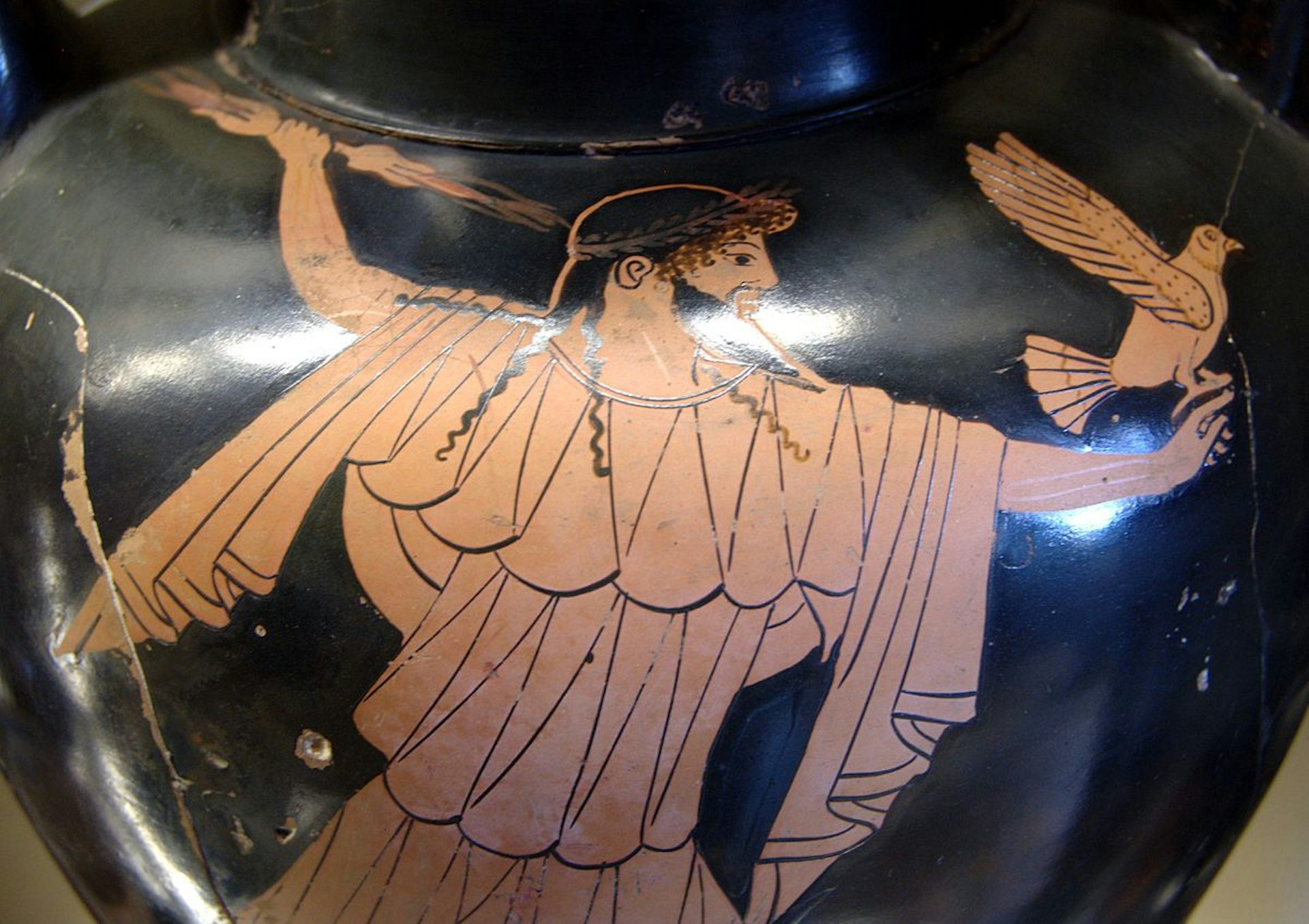
Attic red-figure amphora by the Berlin Painter (c. 480–470 BCE) showing Zeus wielding a thunderbolt and holding an eagle
Louvre Museum, Paris / Bibi Saint-PolPublic DomainZeus’ gamble turned the tide in his favor. With his full force now assembled, the god unleashed his fury. He and his supporters fought from Mount Olympus, while the Titans fought from Mount Othrys to the south. Hesiod renders this scene in dramatic detail:
Then Zeus no longer held back his might; but straight his heart was filled with fury and he showed forth all his strength. From Heaven and from Olympus he came forthwith, hurling his lightning: the bolts flew thick and fast from his strong hand together with thunder and lightning, whirling an awesome flame. The life-giving earth crashed around in burning, and the vast wood crackled loud with fire all about. All the land seethed, and Ocean's streams and the unfruitful sea. The hot vapour lapped round the earthborn Titans: flame unspeakable rose to the bright upper air: the flashing glare of the thunder-stone and lightning blinded their eyes for all that there were strong. Astounding heat seized Chaos: and to see with eyes and to hear the sound with ears it seemed even as if Earth and wide Heaven above came together; for such a mighty crash would have arisen if Earth were being hurled to ruin, and Heaven from on high were hurling her down; so great a crash was there while the gods were meeting together in strife.[65]
Following his victory, Zeus banished the Titans to Tartarus and ordered the Hecatoncheires to keep eternal watch over them.[66]
The Division of the Cosmos
After defeating the Titans, Zeus divided the cosmos among his siblings. Together, the Olympian gods and goddesses—so named because they lived atop Mount Olympus—ushered in a new era.
According to Hesiod, Gaia advised the new gods to accept Zeus unanimously as their ruler; in return, Zeus apportioned honors and functions as he saw fit. To Demeter he granted control over agriculture; to Poseidon, the seas; to Hades, the Underworld; to Hera, the domestic and maternal sphere; and to Hestia, the domain of the home and hearth.[67]
In an alternative tradition, Zeus and his siblings (or rather, his brothers) divided the cosmos via lottery. Zeus thus won the heavens, Poseidon the sea, and Hades the Underworld, while “the earth and high Olympus” were shared by all three.[68]
Zeus eventually took Hera for his wife. In an early tradition (alluded to in the Iliad), Zeus first made love to Hera in secret while she was still in her father’s home, briefly leaving his hiding place to do so. [69]
In another myth, Zeus seduced Hera by turning himself into a cuckoo. He flew to Hera’s window and did not resume his true form until the object of his affections had brought him inside and embraced him.[70]

A fourth-style fresco from the House of the Tragic Poet in Pompeii, showing the marriage of Zeus (right, seated) and Hera (center, standing)
National Archaeological Museum, Naples / ArchaiOptixCC BY-SA 4.0Zeus and Hera were married in a lavish wedding attended by all the gods. The couple received an especially glorious present from Gaia, the goddess of the earth, who gave them a golden apple tree. Hera kept this tree in the remote Garden of the Hesperides, where the hero Heracles would later be sent on one of his famous labors.[71]
Challenges to Zeus’ Rule
Typhoeus
Though mighty Zeus had imposed order over his unruly peers, lasting peace proved elusive. It was now Gaia’s turn to stir the pot. Enraged over the defeat and imprisonment of her Titan sons and daughters, Gaia conceived a final child with Tartarus (another primordial deity and the personification of the Underworld). This child was a monstrous being called Typhoeus (or Typhon):[72]
From his shoulders grew an hundred heads of a snake, a fearful dragon, with dark, flickering tongues, and from under the brows of his eyes in his marvellous [sic] heads flashed fire, and fire burned from his heads as he glared.[73]
But with the aid of the thunderbolts given to him by the Cyclopes, Zeus soon defeated Typhoeus, hurling him down into Tartarus along with the rest of the Titans.[74]
The Gigantomachy
In another well-known tradition, the goddess of the earth was said to have sent the Giants (also called Gigantes) against Zeus and the Olympians. The Giants were Gaia’s offspring; according to Hesiod, they were born from the blood that spilled when Uranus was castrated by Cronus.[75] Hyginus, on the other hand, claimed the Giants were the sons of Gaia and Tartarus.[76]
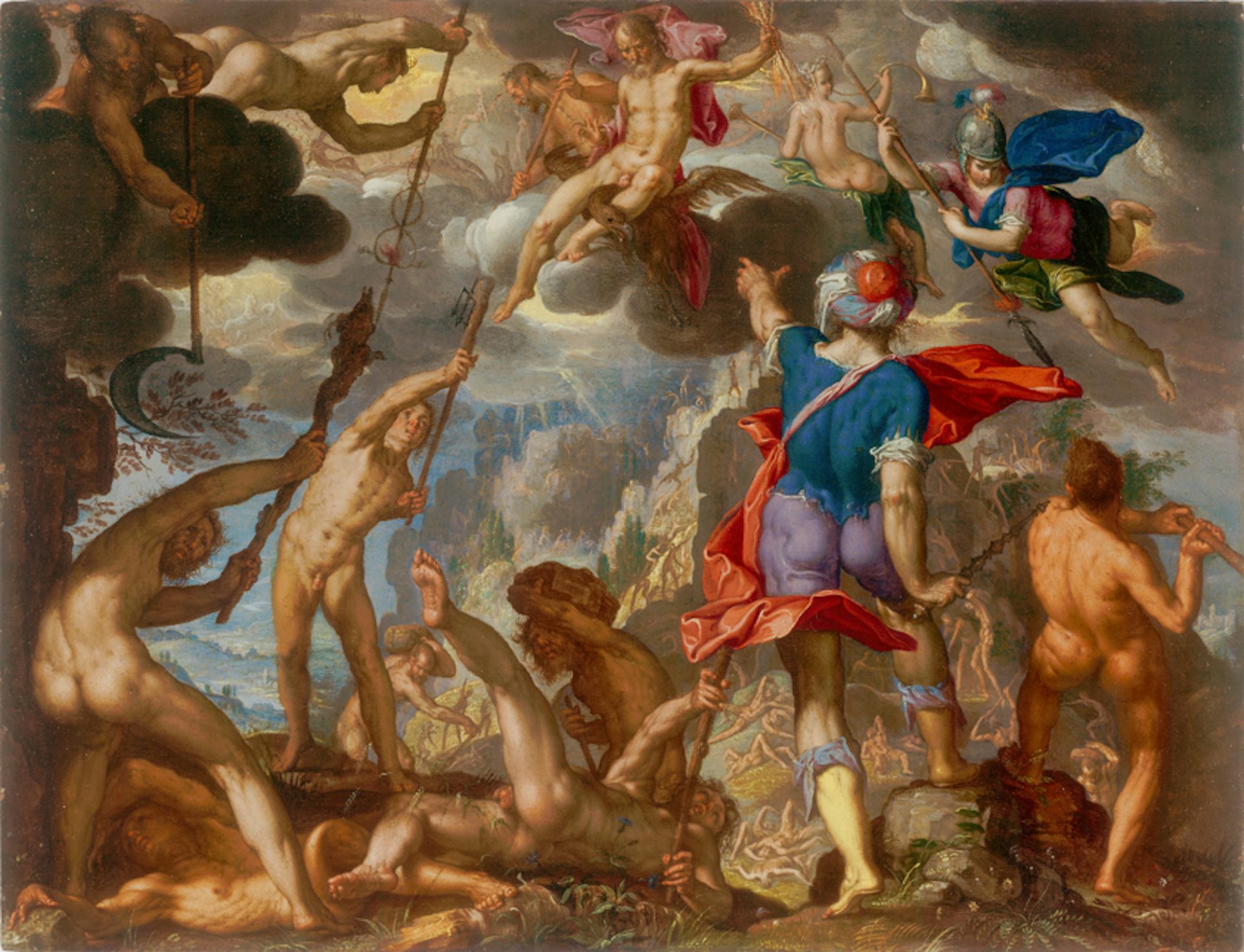
The Battle between the Gods and the Giants by Joachim Wtewael (1608).
Art Institute of ChicagoPublic DomainThe Giants were fantastically strong and arrogant, though not necessarily exceptionally tall (the quality most commonly associated with the term “giant” nowadays). In later literary and artistic depictions, they had serpentine features, such as scaly feet, snakes for legs, or snake hair.[77]
The war between the Olympians and the Giants, called the Gigantomachy, does not appear in the earliest Greek texts. Neither Homer nor Hesiod describe this conflict, though they may allude to it.[78]
According to the poet Pindar (fifth century BCE), the Gigantomachy was fought on the plain of Phlegra in northern Greece.[79] Both Pindar and other authors assigned a major role in the conflict to Heracles, Zeus’ son by the mortal woman Alcmene; apparently, there had been a prophecy that only Heracles could defeat the Giants.[80]
The two most powerful Giants were named Porphyrion and Alcyoneus. Porphyrion was killed by either Apollo[81] or by Zeus and Heracles,[82] while Alcyoneus was killed by Heracles. The other Olympians, including Athena, Dionysus, and Hera, also participated in the fierce battle. In the end, the Giants were defeated and killed.
The Aloads
The Aloads—named Otus and Ephialtes—were the sons of the god Poseidon and the princess Iphimedia.[83] They were prodigiously tall and strong from an early age and wished to attack Olympus so they could carry off the goddesses to be their brides.
To accomplish this goal, they piled two mountains, Pelion and Ossa, on top of each other to ascend to Olympus and battle the Olympians. In one version, they even managed to capture and imprison Ares for thirteen months. Ultimately, though, Otus and Ephialtes were killed, either by the Olympian gods or by one another (accidentally).[84]
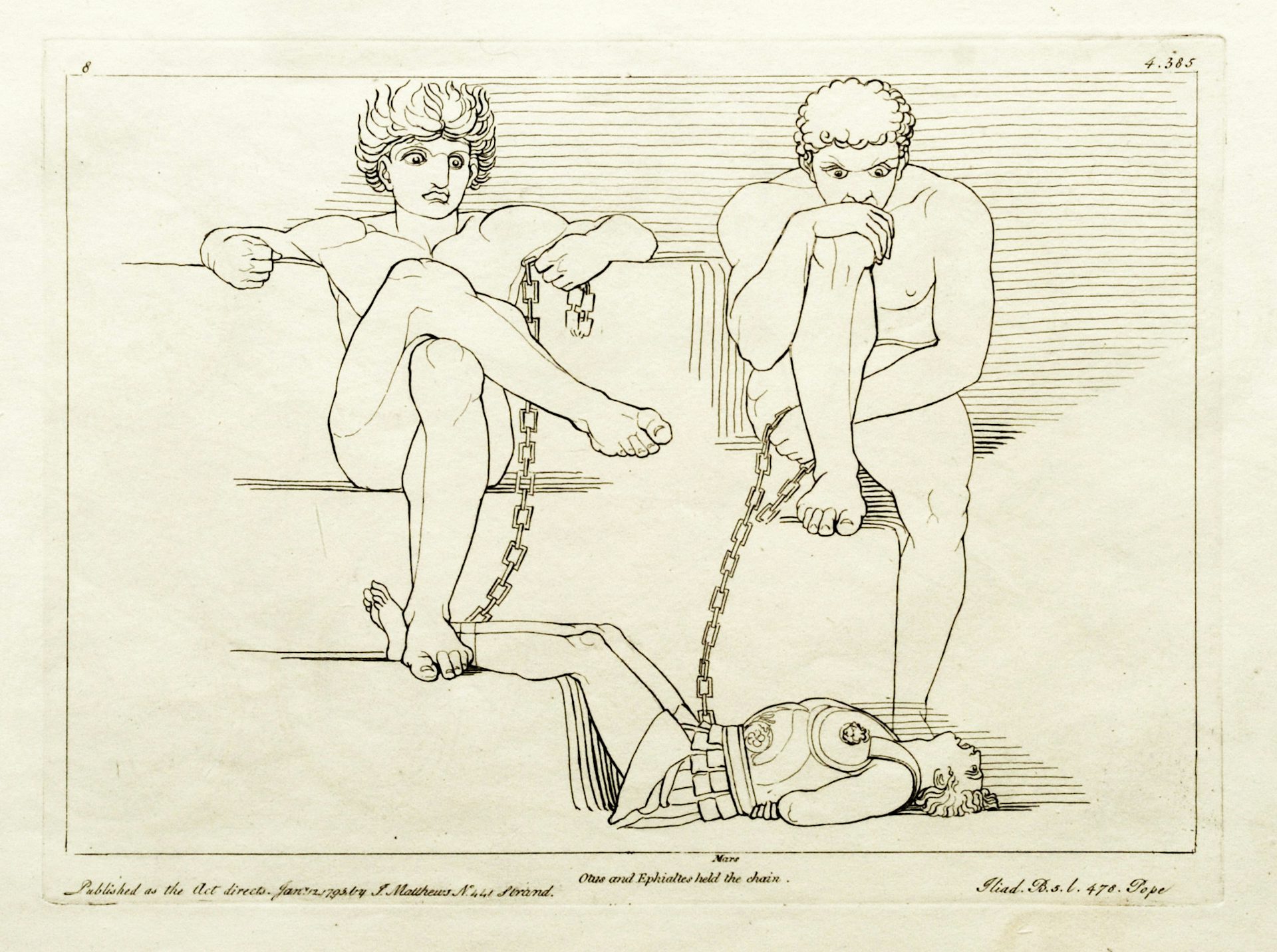
Illustration showing the Aloads holding Ares captive by John Flaxman (1795)
Wikimedia CommonsPublic DomainHera’s Revolt
At some point during his reign (it is unclear when exactly), Zeus was challenged by his wife Hera. Together with Poseidon, Athena, and several other Olympians, Hera rose up against Zeus, stealing his thunderbolts while he was sleeping and binding him in adamantine chains.
But Zeus was soon saved by Thetis, a Nereid and minor sea goddess. Thetis called Briareus, one of the Hecatoncheires, who released Zeus from his chains. He immediately sprang up, seized his thunderbolts, and cowed the other gods into submission. Zeus punished the Olympians severely, especially Hera, and made them all swear never to challenge his power again.[85]
Zeus and Humanity
Zeus, Prometheus, and the Creation(s) of Humanity
As the supreme god, Zeus had a role in the creation of humankind, though sources disagree on how exactly humans came about. There are two well-known creation stories, and it is not entirely clear how they relate to one another.
The first tells of many separate creations, each inaugurating a distinctive age of humankind. According to Hesiod, there were five ages: the Golden Age, the Silver Age, the Bronze Age, the Heroic Age, and the Iron Age.[86] Ovid, writing some centuries after Hesiod, described only four ages, seemingly merging the Bronze Age and the Heroic Age.[87]

The Golden Age by Lucas Cranach the Elder (ca. 1530)
Alte Pinakothek, MunichPublic DomainIn each age, Zeus had a decisive part to play. Zeus was born during the Golden Age, and also brought it to an end by sparking the cataclysmic conflict known as the Titanomachy. Although he did not start the Silver Age, he ended it by destroying the foolish mortals who populated it when they refused to honor the gods.
Zeus himself created the third race: the strong and warlike humans of the Bronze Age, who were so powerful and aggressive that they destroyed themselves. He created the heroes of the fourth age as well, but most of them died during the Trojan War and the war of the Seven against Thebes, a mythical conflict made famous by the playwright Aeschylus.
Zeus also created the people of the Iron Age (the final age), the era of the classical city-states and the time in which Hesiod himself lived. This was an age marred by perpetual strife, folly, and the loss of common morality.
The second creation myth (and the better known of the two) involved Zeus’ erstwhile ally, the Titan Prometheus. According to this later version, Zeus instructed Prometheus to create the first humans. Prometheus complied, molding them out of clay.[88]
All was well until Prometheus deceived Zeus over a matter involving animal sacrifice: he ensured that the gods would forever receive only the less desirable portions of the animal (the bones and fat), while the humans would consume the meat themselves. Zeus would have forgiven this offense, but Prometheus made things even worse by defying Zeus’ wishes and stealing fire from the gods to give to the humans.
In stealing fire, Prometheus had gone too far. Zeus now sought revenge and devised a particularly macabre punishment for his one-time ally: he fastened Prometheus to a rock and had an eagle eat his immortal liver every day. Prometheus' liver regrew each night, ensuring that this punishment would continue for all eternity.
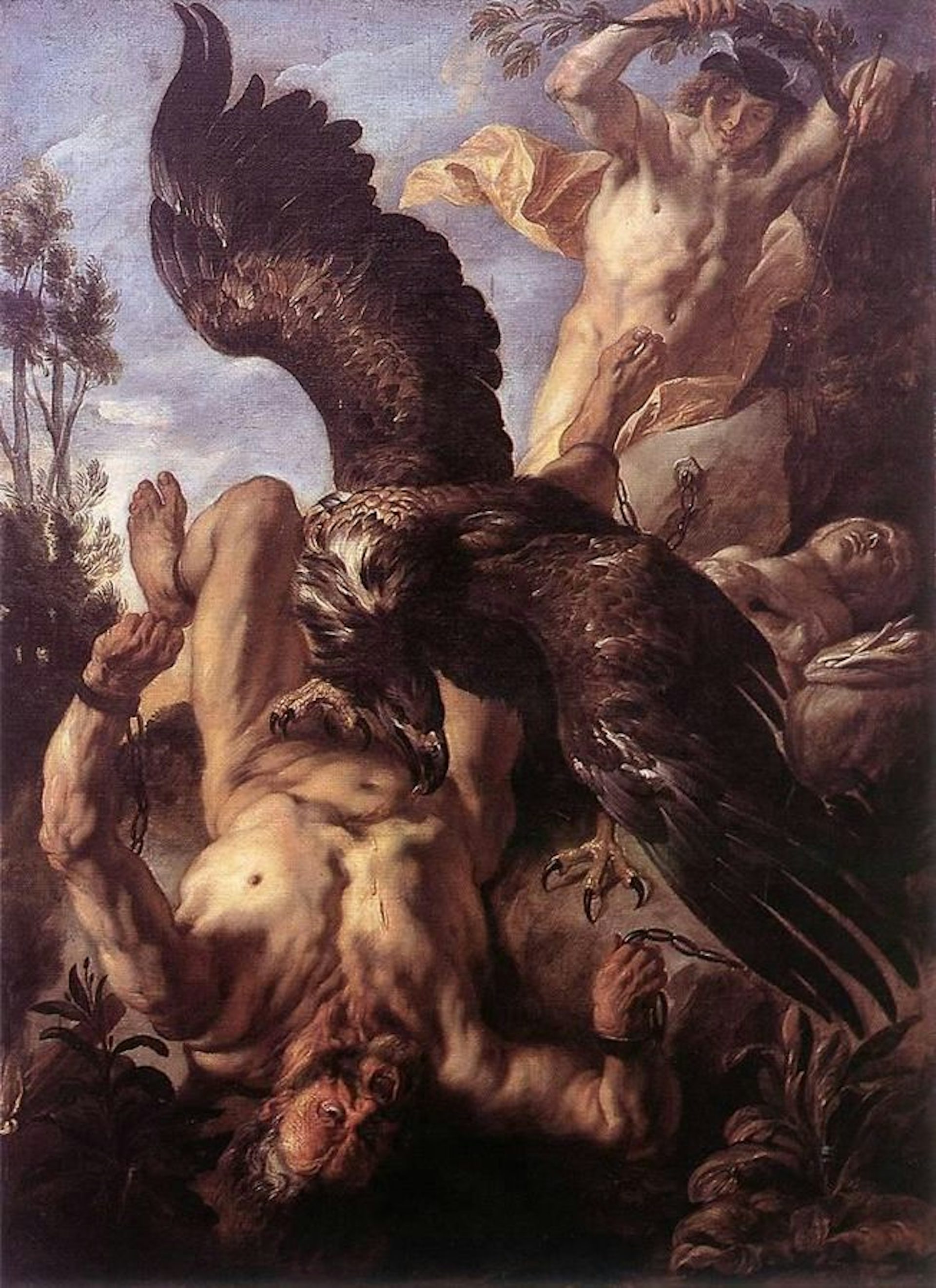
Prometheus Bound by Jacob Jordaens (1640). Wallraf-Richartz Museum, Cologne.
Wikimedia CommonsPublic DomainIn order to revenge himself upon the humans, Zeus had his children Hephaestus and Athena fashion a woman named Pandora. Before she was sent to earth, Pandora was celebrated by the gods and given priceless gifts, including a sealed jar she was told never to open.
Eventually, curiosity got the better of her—as Zeus knew it would—and Pandora opened the jar, releasing a host of evils upon the humans, including death (up until this point, humans had been immortal), war, famine, disease, and countless others. By the time Pandora covered the jar, only hope remained, leaving the humans to wander in a hopeless, fallen world.[89]
This was not the only time Zeus clashed with human beings. In another story, the Arcadian king Lycaon (or, in an alternative version, Lycaon’s sons) tried to trick Zeus into eating human flesh when he came to visit the human world. Disgusted by this savagery, Zeus did not hesitate to punish the sinner(s); in some accounts, he even decided to wipe out all mankind with a devastating flood.[90]
Only two human beings—Prometheus’ pious son Deucalion and his wife Pyrrha—survived Zeus’ flood. Faced with the task of repopulating the earth, Deucalion and Pyrrha were instructed by an oracle to throw stones over their shoulders. Those stones were magically transformed into a new race of humans.[91]
The Mortal Lovers of Zeus
Though Zeus’ marriage to Hera endured (unlike his prior marriages), he continued to take other lovers. Indeed, Zeus’ many eventful infidelities are important and consequential parts of his legend. In one passage in the Iliad, Zeus even brags of his many affairs to Hera herself.[92]
Among the immortals, Zeus’ lovers included Leto, Demeter, and Dione. According to some traditions, Dione became the mother of Aphrodite.
Zeus also had many mortal lovers—mostly women, though Ganymede, a handsome prince of Troy and the cupbearer of the gods, was one famous male exception. Zeus often transformed himself into fantastic creatures in order to have his way with the women who caught his eye. The children born to Zeus from these unions were often important heroes and founders.

Rembrandt - The Abduction of Europa, 1632, oil on a single wood panel.
Wikimedia CommonsPublic DomainIn one myth, Zeus fell in love with Europa, daughter of a Phoenician king. After transforming himself into a beautiful white bull, he approached Europa while she was playing on the seashore and gently coaxed her onto his back.
Once he had her, he whisked her away to the island of Crete. Europa went on to become the queen of Crete and bore Zeus three sons: the wise Rhadamanthys, the long-lived Sarpedon, and Minos, creator of the Labyrinth.[93]
To seduce Danae, an Argive princess imprisoned by her own father, Zeus turned himself into a shower of fine gold. From this union was born Perseus, the hero who killed the Gorgon Medusa.[94]
Another mortal, Leda, was seduced by Zeus in the guise of a swan—a scene memorably imagined by William Butler Yeats in his poem “Leda and the Swan”:
A sudden blow: the great wings beating still Above the staggering girl, her thighs caressed By the dark webs, her nape caught in his bill, He holds her helpless breast upon his breast.[95]
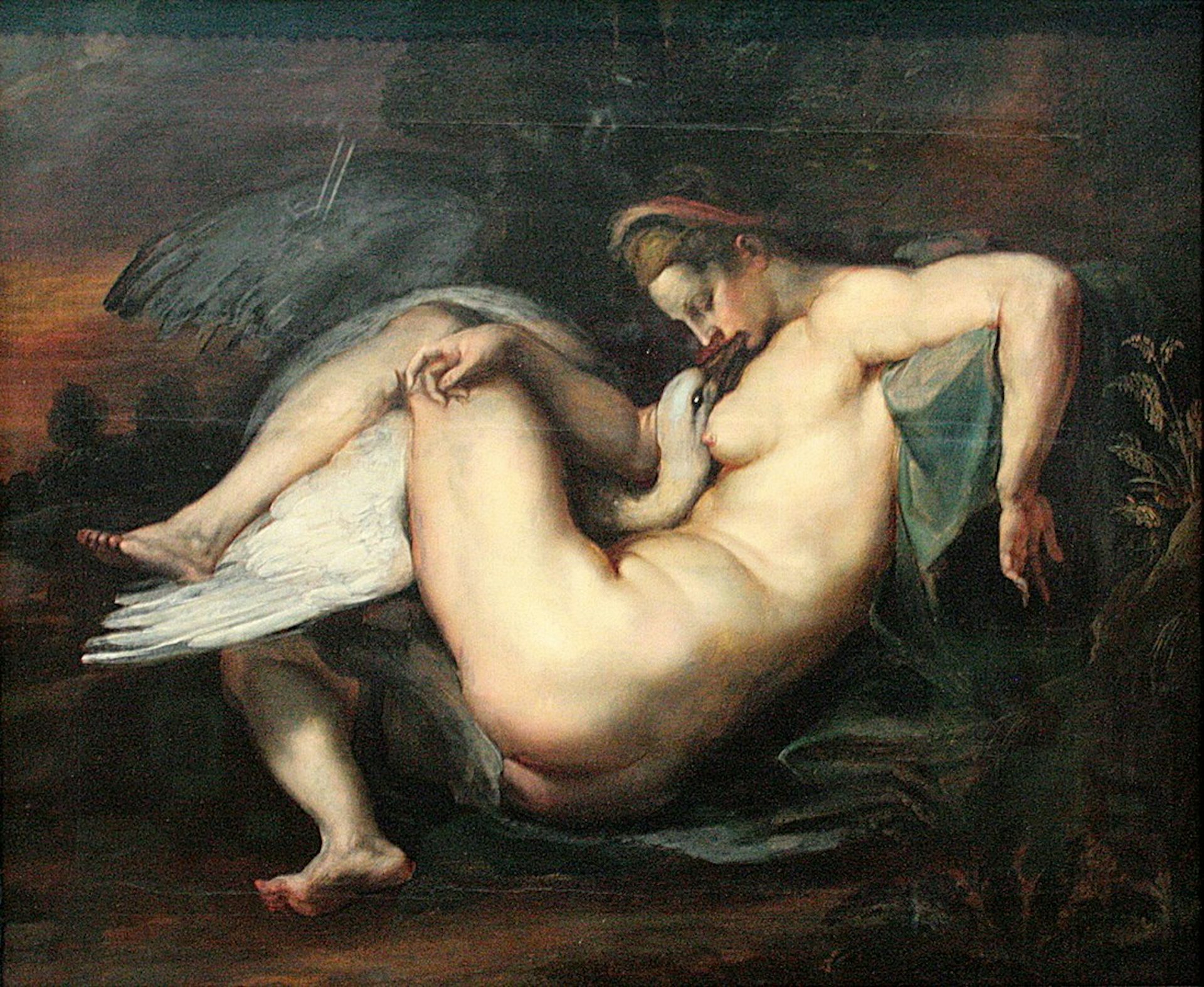
Peter Paul Rubens - Leda and the Swan, 1602, Staatliche Kunstsammlungen Dresden
Wikimedia CommonsPublic DomainLeda ended up giving birth to several children (who, according to some accounts, emerged from an egg). At least one of these children, the beautiful Helen, was the product of Leda’s union with Zeus. Another child, Clytemnestra, was the daughter of Leda and her husband Tyndareus, the king of Sparta.
The other two children, the twins Castor and Polydeuces (the so-called “Dioscuri”), were the sons of either Zeus or Tyndareus (there were different versions, with some sources making Polydeuces the son of Zeus and Castor the son of Tyndareus).[96]
In another myth, Zeus seduced Alcmene, a princess from the Argolid, by assuming the form of her absent husband Amphitryon. Later that same night, Alcmene also slept with the real Amphitryon. From this union were born two sons: Iphicles, son of the mortal Amphitryon, and Heracles, the impossibly strong son of the god Zeus.[97]
Other tales of Zeus’ dalliances with mortal women did not end so happily. When Hera caught wind of Zeus’ affair with Io, for example—a princess of Argos and a priestess in the temple of Hera—she did everything in her power to ruin the poor girl.
Over the course of her trials, Io was transformed into a cow, imprisoned by the hundred-eyed Argus Ponoptes, and chased by a gadfly to Egypt, where she finally recovered her human form. She ultimately gave birth to Epaphus, ancestor of the Egyptian and Libyan kings.[98]
Hera also interfered in the affair between Zeus and the Theban princess Semele, with disastrous consequences. Jealous of her husband’s new lover, Hera approached Semele in disguise and convinced her to force Zeus to “prove” his identity by presenting himself to her in his true form. The sight of the undisguised Zeus proved too much for the mortal Semele, and she burst into flames.
Zeus did, however, rescue Semele’s unborn son, whom he sewed into his thigh as a surrogate womb. This son would later become Dionysus, the god of wine.[99]
The relationship between Zeus and Callisto also ended tragically. An attendant of the virgin goddess Artemis, Callisto was shunned by her mistress when her pregnancy was discovered and was transformed into a bear (by either Artemis, Hera, or even Zeus). Callisto’s son Arcas became the ancestor of the Arcadians and eventually joined his mother in the heavens as a constellation.[100]
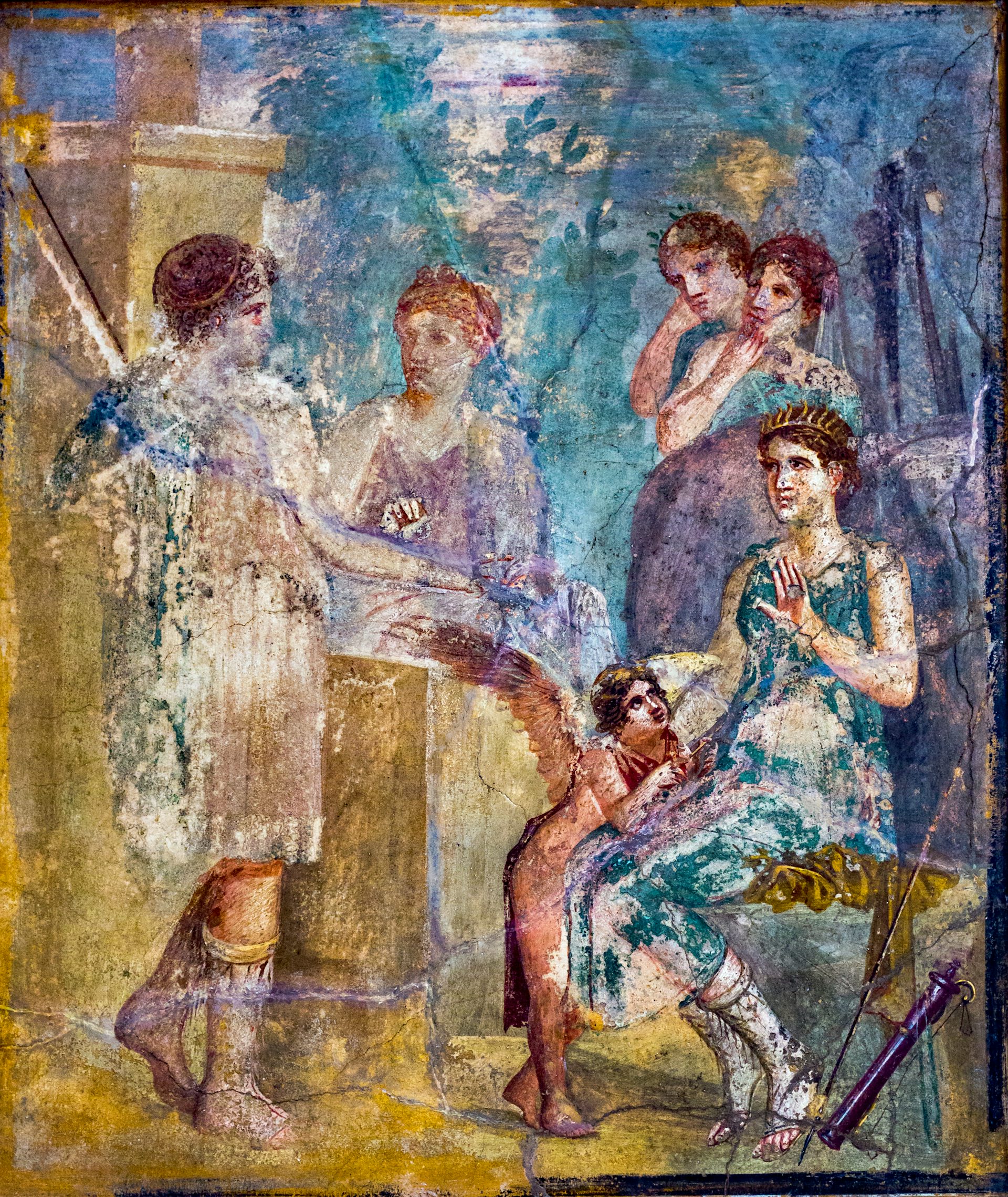
Fourth-style fresco from Pompeii showing Callisto (left) with Artemis (right) and a winged Eros (center)
National Archaeological Museum, Naples / ArchaiOptixCC BY-SA 4.0Zeus and the Heroes
Zeus frequently intervened in mortal affairs, either to maintain the natural order or to mete out justice to the ever-erring race of humans.
Zeus was especially prolific as a father of heroes. Indeed, according to some accounts, it was not mere lust that drove Zeus to pursue so many love affairs, but rather the knowledge that these affairs were the only way to populate the mortal world with the heroes it needed.
In the Shield of Heracles, an early poem attributed (albeit incorrectly) to Hesiod, Zeus seduces Alcmene because he wishes to produce a son—Heracles—who will “defend against destruction gods and men who eat bread.”[101]
Sure enough, a number of Zeus’ most famous children—including Heracles and Perseus—made a name for themselves by killing monsters and championing civilization and order. In one important myth, Heracles even saved the Olympian gods from being destroyed by the Giants (see above).

Perseus Beheading Medusa by Francesco Maffei (ca. 1650)
Gallerie dell’Academia, VenicePublic DomainZeus preserved order in the human realm in other ways, too. When Phaethon, the mortal son of Helios, lost control of the chariot of the sun, it was Zeus who struck the boy down to prevent him from scorching the earth.[102]
Zeus was also known to punish egregious wrongdoing, as when he shipwrecked the Argonauts for killing Apsyrtus,[103] or when he caused Alcmaeon’s children to grow to adulthood in an instant so they could avenge their father’s murder.[104]
Zeus was a master planner; indeed, one of his Homeric epithets was μητίετα (mētíeta), sometimes translated as “all-wise” or “wise counselor.”[105] Zeus took great pains to ensure the fulfillment of all his plans, seeing to it that his will was done in the world.
One early tradition even claimed that the entire Trojan War had been masterminded by Zeus as a solution to overpopulation. As the story went, Gaia, overburdened by the proliferation of human beings, complained of her plight to Zeus. Zeus responded by orchestrating the events that would lead to the Trojan War, a conflict he knew would claim many lives, thus relieving Gaia of her burden.[106]
The events of the Iliad put Zeus’ abilities as a planner on full display. Set during the ninth year of the Trojan War, the Iliad tells of how Achilles, the greatest of the Greek heroes at Troy, quit the fighting after a bitter quarrel with Agamemnon, the leader of the Greek army.
But Achilles wanted to make sure the Greeks suffered for insulting him, so he asked his mother, the goddess Thetis, to have Zeus turn the tides of war in favor of the Trojans, the Greeks’ opponents.
Thetis, taking pity on her son, relayed this request to Zeus, and Zeus agreed to it. With a nod of his great head, the god promised to let the Trojans beat back the Greeks until Achilles’ pride was healed:
Come, I will bow my head to you, that thou may be certain, for this from me is the surest token among the immortals; no word of mine may be recalled, nor is false, nor unfulfilled, to which I bow my head.[107]

Jupiter and Thetis by Jean-Auguste-Dominique Ingres (1811)
Musée Granet, AixPublic DomainTrue to his word, Zeus breathed strength and courage into the Trojans. He even forbade the other gods from lending support to either side so that his plan could be fulfilled.
In one episode narrated in the Iliad, Hera—a staunch supporter of the Greeks—finally decided to distract Zeus so that Poseidon could help the Greeks resist the Trojan onslaught. She decked herself out in her best finery to inspire Zeus’ lust (even borrowing the seductive girdle of Aphrodite, the goddess of love). Once the two of them had lain together, she had Hypnos, the god of sleep, put Zeus into a deep slumber.
Her plan worked—until Zeus awoke and discovered Hera’s treachery. The god flew into a rage, threatening to put Hera in chains and forcing Poseidon to again withdraw his aid.[108]
Zeus continued his temporary support of the Trojans, all in the name of placating Achilles, but even the king of the gods had to accept that Troy was fated to be defeated. At last, when Hector, the leader of the Trojans, killed Achilles’ best friend Patroclus, Achilles returned to the fighting so that he could take his revenge.
At that point, Zeus permitted the gods to intervene as they had before. Achilles killed Hector, and the war dragged on.[109]
Though the Iliad ends with Hector’s funeral, the war was not yet over. In the following months, Zeus continued to guide events as more and more heroes and warriors fought and died. Eventually, the Greek hero Odysseus devised the clever stratagem of the “Wooden Horse” (or “Trojan Horse”), allowing the Greeks to infiltrate Troy’s wall and sack the city.
Alternative Mythologies
Certain religious communities and authorities within the Greek world adopted a very different version of the god Zeus, complete with a very different mythology.
One early author, Pherecydes of Syros, presented an alternative to the widely known theogony of Hesiod. According to Pherecydes, Zeus was originally called Zas; he and Chronos (“Time”) were the original beings of the cosmos, having always existed. Eventually, Zas seems to have become Zeus (it is unclear how this came about), and he ruled as king of the cosmos thereafter.[110]
On the other hand, the Orphics—a religious community that professed to follow teachings handed down by the mythical musician Orpheus—assigned Zeus a relatively minor role in the creation and governance of the cosmos. Their cosmogony was centered instead on an obscure deity called Protogenus (“First-Born”)—though there may have been a myth in which Zeus eventually took power by swallowing Protogenus.[111]
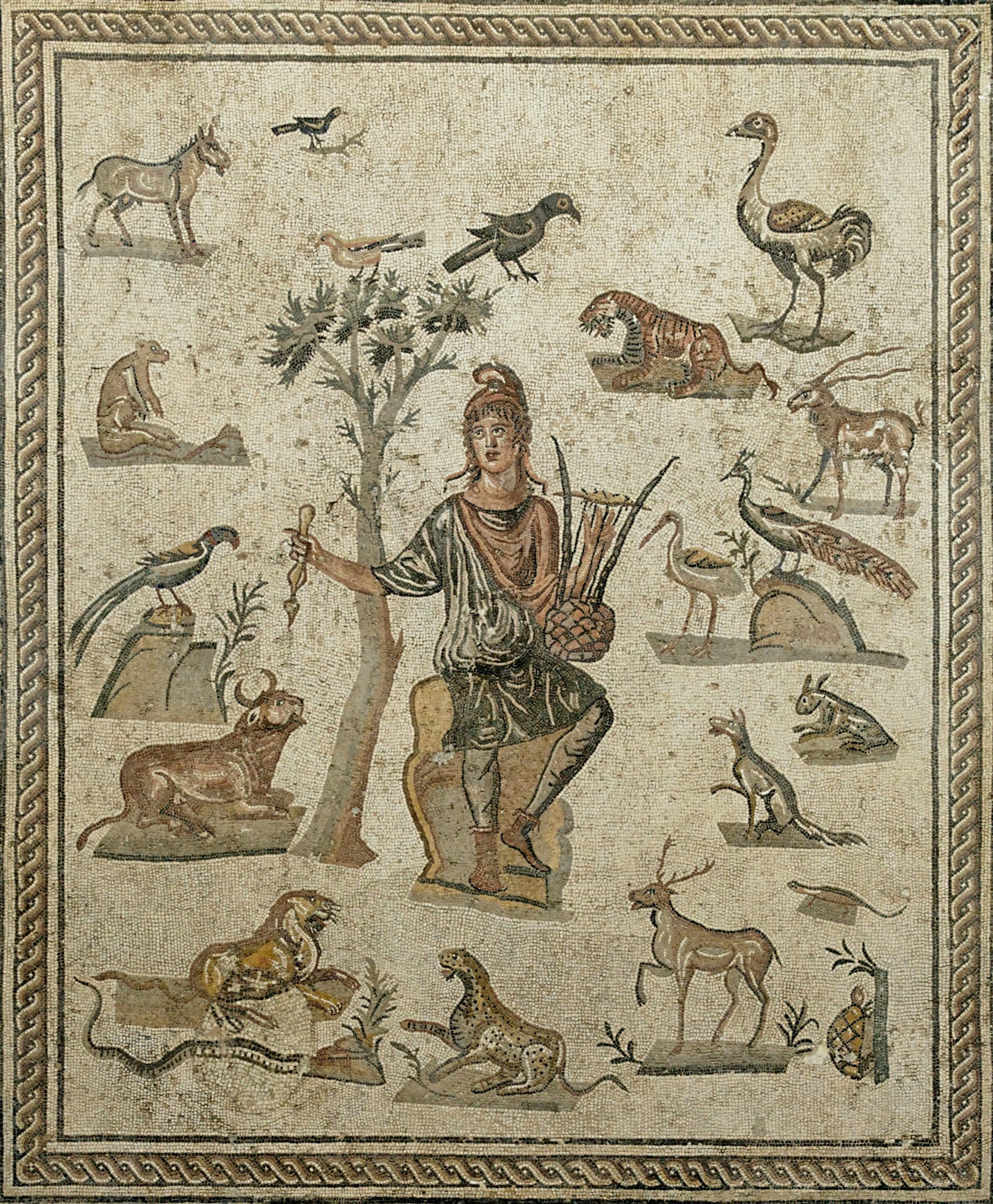
Roman floor mosaic from Palermo showing Orpheus surrounded by animals (ca. 200–250 CE)
Regional Archaeological Museum, Palermo / Marie-Lan NguyenCC BY 2.5Nonetheless, Zeus did appear in one key Orphic myth involving the origins of Dionysus. The myth told of how Zeus mated with his mother Rhea (or his sister Demeter) to produce Persephone. He then mated with his daughter Persephone to produce Dionysus—who was torn apart by the Titans soon after. Seeing this monstrous deed, Zeus blasted the Titans with his thunderbolt, and the first humans were created from their ashes.[112]
Worship
Temples
Beautiful temples to Zeus were erected throughout the ancient world, from the sixth century BCE on. The most important of these were located in Athens, Acragas (in Sicily), and Olympia. The temple of Zeus at Olympia was particularly famous for its statue of Zeus; sculpted from gold and ivory by the artist Phidias, it was one of the Seven Wonders of the Ancient World.
Zeus also had a Panhellenic cult and sanctuary at Nemea, where the Nemean Games were held in antiquity. There he was worshipped in connection with the infant Opheltes, in whose honor the Nemean Games were said to have been established. The temple of Zeus at Dion, on the lower slopes of Mount Olympus, was also influential, especially during the Hellenistic period.
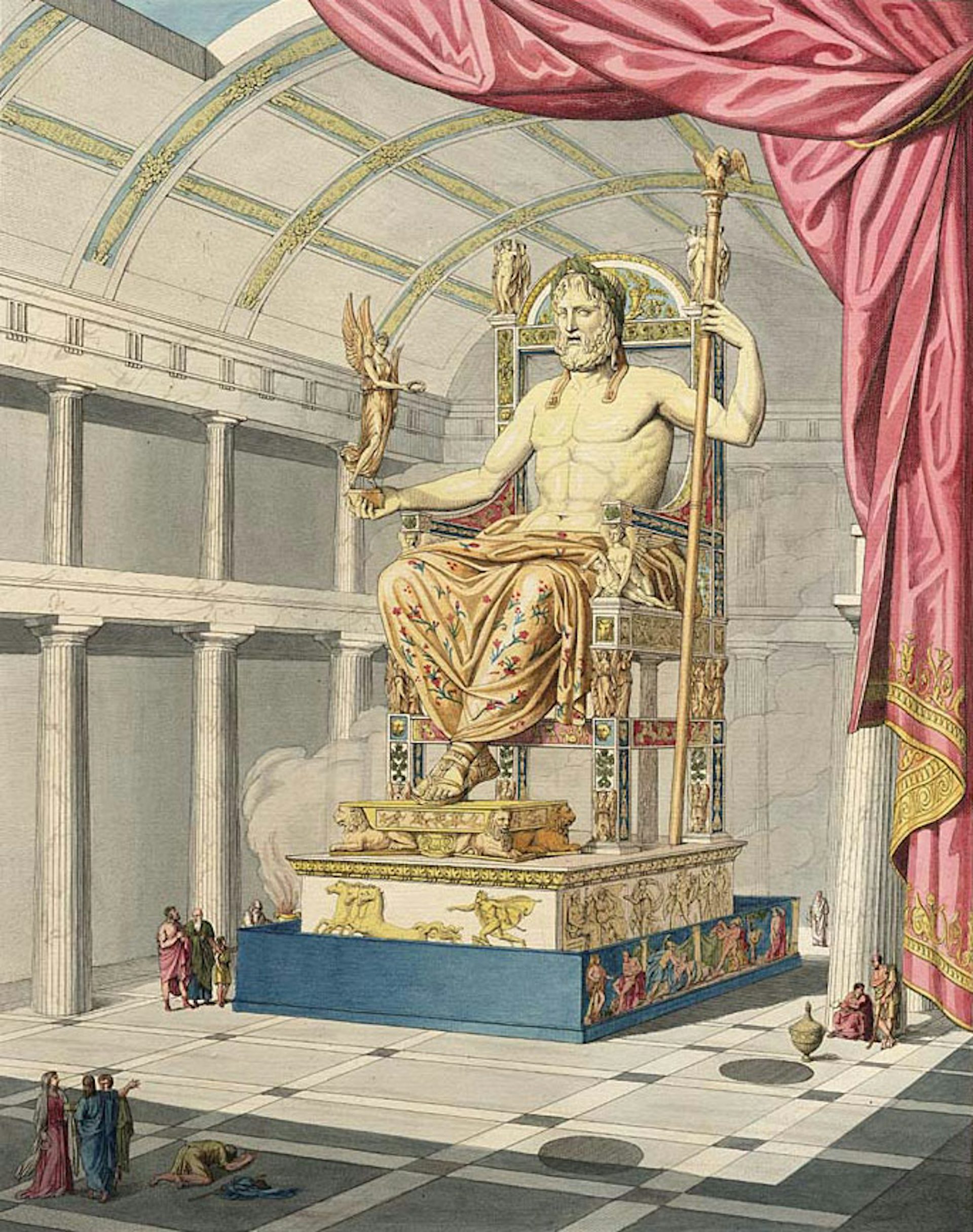
Illustration depicting how the enormous statue of Zeus at Olympia may have appeared by Quatremère de Quincy (1815).
Wikimedia CommonsPublic DomainAnimal sacrifice was one of the cornerstones of Zeus’ worship. In Olympia, there was even an altar dedicated to Zeus built not of stone but from the burned remains of the animals previously sacrificed there.
In many individual Greek city-states, Zeus’ domain was the public marketplace (the agora), where he was thought to supervise commerce and public life. In Athens, Zeus had important public altars on the acropolis and the agora, reflecting his roles as god of the polis or city-state (Zeus Polieus) and of the phratry or clan (Zeus Phratraios).
Zeus was also regarded as a prophetic or oracular god. He had important oracles at Olympia, Dodona (in northern Greece), and the Siwa Oasis (in Libya). The oracle of Zeus at Dodona was particularly ancient and influential: in fact, it may have been the earliest oracle in all of Greece.
Homer spoke of priests of Zeus at Dodona called Selloi,[114] but by historical times it seems the oracle only had priestesses.[115] It was also said that at Dodona, Zeus spoke through his sacred oak trees, or through the doves that flew through those trees.[116]
Finally, Zeus was often worshipped as Zeus Herkeios, the protector of the household, sometimes receiving sacrificial offerings in the courtyards of individual homes. According to one authority, every Athenian family had to have a shrine to Zeus Herkeios in their home.[117] Through his connection with the household, he was also worshipped as Zeus Ephestios (Zeus of the Hearth) and Zeus Ktesios (Zeus of Property).
Festivals and Rituals
The most important festivals to Zeus in the ancient world were Panhellenic, meaning they were celebrated by all Greeks, not just individual cities. These included the Olympic Games, held at Olympia every four years. The games were initiated with elaborate rites and sacrifices that took place in a complex of temples, with the main temple dedicated to Zeus. Zeus was also honored at the Panhellenic games at Nemea, held every two years.
There were also many local festivals to Zeus, though these were typically less important; since Zeus was a Panhellenic god, shared by all Greeks, individual cities rarely claimed him as a special patron deity.
In the region of Attica (whose most important city was Athens), Zeus was celebrated in three local festivals that were held annually: the Dipolieia, centered around a bull sacrifice (which ended in the ritual condemnation of the ax and knife used for the sacrifice);[118] the Diasia, which featured bloodless sacrifices as well as animal sacrifices;[119] and the Diisoteria, held at the harbor town of Piraeus, which involved animal sacrifice and a procession.[120]
On Mount Lycaeum (in Arcadia), a strange festival called the Lycaea was celebrated in honor of Zeus. The rites of this festival involved cannibalism and werewolf stories.[121]
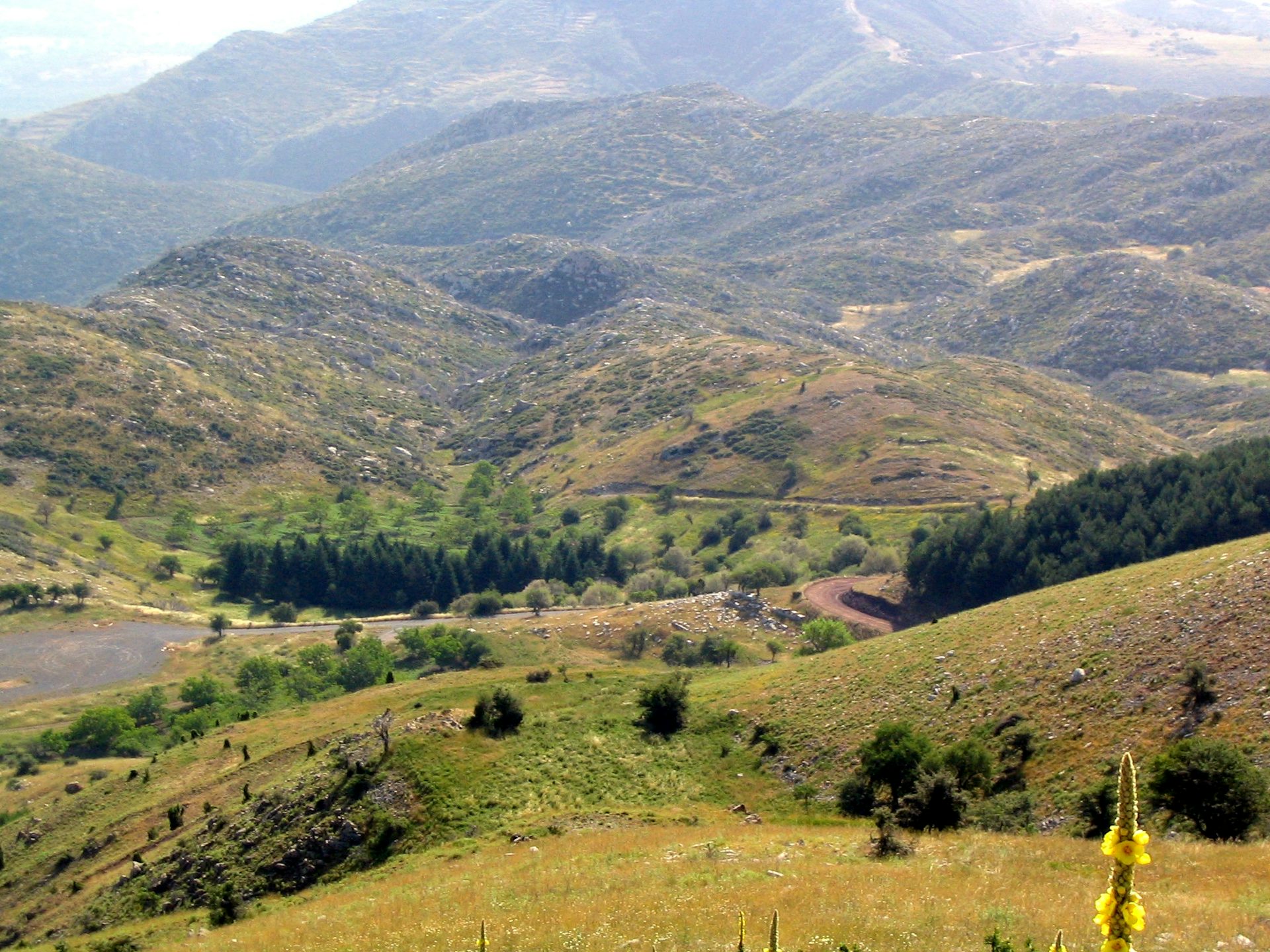
Photo of Mount Lycaon in Arcadia
Danno1CC BY-SA 3.0Zeus’ cult on the island of Crete deserves special mention. Indeed, Zeus was associated with Crete from as early as the Bronze Age; in myth, Crete was usually cited as the place where he was born and raised.
Cretan initiation rituals seem to have reenacted the “sacred time” of Zeus’ infancy, when the Curetes danced around him to protect him. Zeus himself was imagined as a youth or kouros in these rituals, connected with herds and the countryside.[122]
On a smaller scale, Zeus was the chief god invoked at symposiums—Greek drinking parties. Before the symposium began, three libations were poured out: the first to Zeus Olympios (“Olympian Zeus”), the second to the heroes, and the third to Zeus Soter (“Zeus the Savior”).
Foreign Cults
From an early period, the Greeks projected Zeus onto the supreme gods of foreign peoples, a practice sometimes known as interpretatio Graeca (literally, “translation into Greek”). Zeus was thus identified with gods such as the Semitic Baal, the Egyptian Ammon, the Jewish Yahweh, and, perhaps most famously of all, the Italian Jupiter.
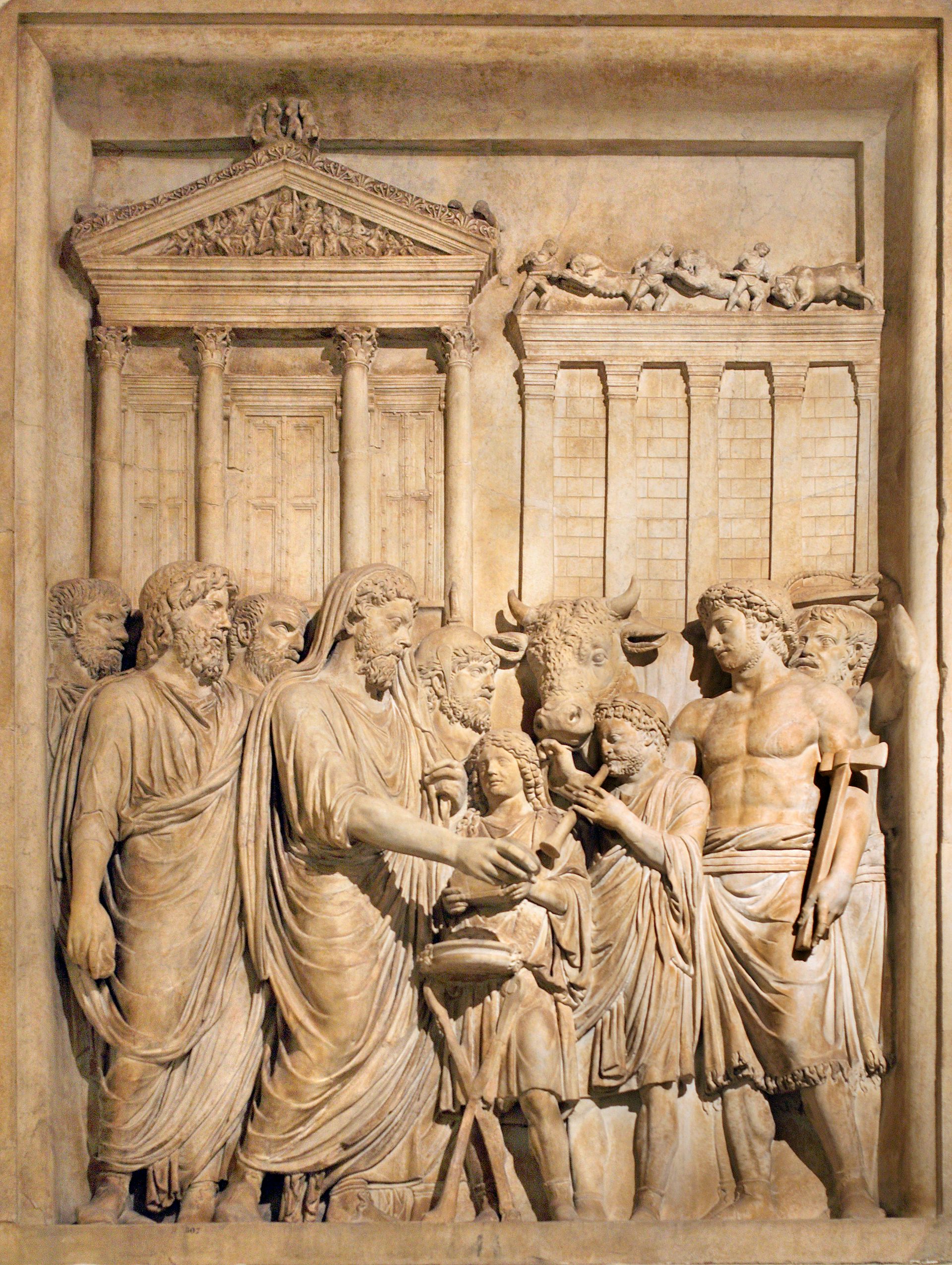
Bas-relief from the Arch of Marcus Aurelius (late second century CE) showing the emperor and his family offering sacrifice before the Temple of Jupiter Optimus Maximus (one of the few surviving depictions of the temple)
Capitoline Museum, Rome / Matthias KabelCC BY-SA 3.0Zeus’ identification with Jupiter was particularly noteworthy. The Romans, in fact, adopted most of Zeus’ mythology and iconography for their own Jupiter, even though the two gods were worshipped very differently.
Like Zeus, Jupiter was the leader of the gods. But Jupiter was a much more political figure than Zeus, serving as the state god of Rome and the guarantor of Roman sovereignty and power. His main temple was an enormous structure on the Capitoline Hill in Rome, known as the Temple of Jupiter Optimus Maximus (“Jupiter the Best and Greatest”).
Pop Culture
Though he is no longer worshipped as he once was, Zeus’ image has persisted in popular culture. He often appears in stories about Hercules, such as the 1970 cult classic Hercules in New York, starring Arnold Schwarzenegger, and the Disney animated film Hercules (1997). He also features in the acclaimed God of War video game series, where he appears as the father of the hero Kratos.
In all of these representations, Zeus’ image is remarkably consistent: a wise, good-natured father figure with a booming voice and a hearty laugh.
Nowadays, Zeus is often shown as distant from the goings-on of Hercules and other mortals. In most pop culture depictions, he is more like a modern monotheistic god than the flawed figure of Greek mythology who was intimately involved in earthly affairs.